Paul van Yperen's Blog, page 233
May 30, 2019
Charlton Heston
Tall, well built and ruggedly handsome American actor Charlton Heston (1923-2008) appeared in 100 Hollywood films over the course of 60 years. With features chiseled in stone, he became famous for playing a long list of historical figures in Biblical epics. For Ben-Hur (1959), he won the Academy Award for Best Actor,
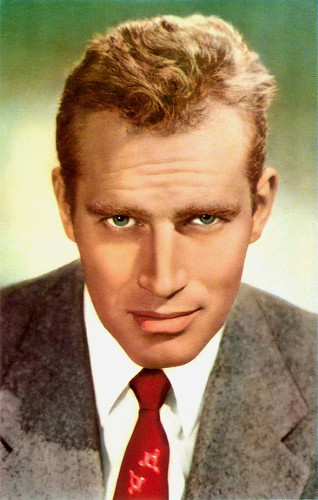
Israelian postcard by Editions de Luxe.
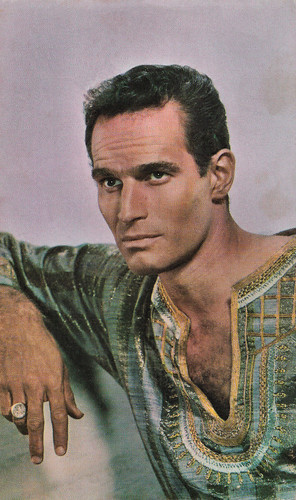
French postcard by E.D.U.G., presented by Corvisart, Epinal, no. 252. Photo: Charlton Heston in Ben-Hur (William Wyler, 1959).
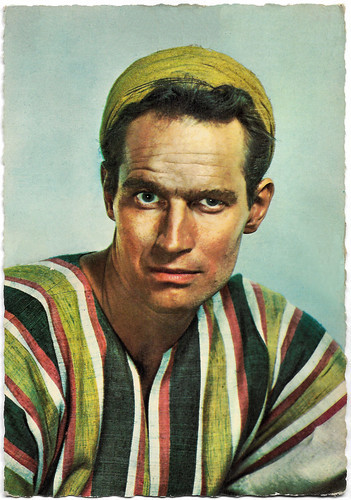
French postcard by E.D.U.G., no. 125. Photo: publicity still for Ben-Hur (William Wyler, 1959).
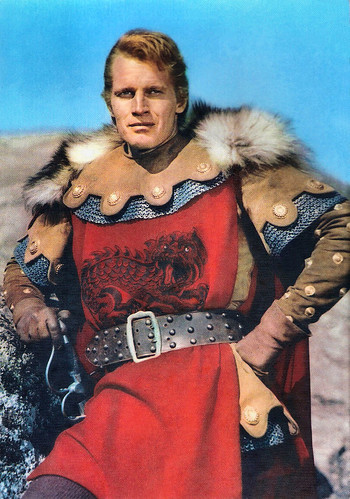
Italian postcard by Rotalcolor, Milano, no. N. 173. Photo: publicity still for El Cid (Anthony Mann, 1961).
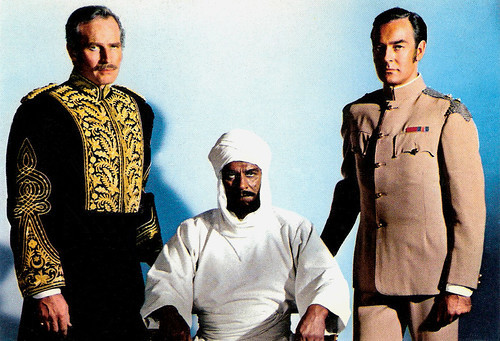
Italian postcard. Photo: Dear Film. Charlton Heston, Laurence Olivier and Richard Johnson in Khartoum (Basil Dearden, Eliot Elisofon, 1965).
A tall, tweedy, rough-hewn sort of chap
Charlton Heston was born John Charles Carter in 1924, in Wilmette, Illinois, U.S., to Lila née Baines and Russell Whitford Carter, who operated a sawmill. He had English and Scottish ancestry, with recent Canadian forebears. When Heston was 10 years old, his parents divorced after having three children. Shortly thereafter, his mother remarried Chester Heston.
Charlton and his younger sister Lilla and brother Alan attended New Trier High School in Wilmette. During high school, he enrolled in New Trier's drama program, playing the lead role in a 16mm production of Peer Gynt (1941), based on the Henrik Ibsen play. It was directed by future film activist David Bradley.
From the Winnetka Community Theatre in which he was active, he earned a drama scholarship to Northwestern University; among his acting teachers was Alvina Krause. In 1944, Heston married Northwestern University student Lydia Marie Clarke, who was six months his senior. That same year he enlisted in the United States Army Air Forces. He served for two years as a radio operator and aerial gunner aboard a B-25 Mitchell stationed in the Alaskan Aleutian Islands with the 77th Bombardment Squadron of the Eleventh Air Force. He reached the rank of Staff Sergeant.
After the war, the Hestons lived in Hell's Kitchen, New York City. Heston made ends meet by posing as a model in New York at The Art Students League, across from Carnegie Hall. Seeking a way to make it in theatre, the couple decided to manage a playhouse in Asheville, North Carolina, in 1947, making $100 a week.
In 1948, they returned to New York, where Heston was offered a supporting role in a Broadway revival of William Shakespeare's 'Antony and Cleopatra', starring Katharine Cornell. In television, Heston played a number of roles in CBS's Studio One, one of the most popular anthology dramas of the 1950s. These included a part as Marc Antony in a televised production of Julius Caesar (1950). He was unable to use his real name, John Carter as an actor because it bore too close a resemblance to the name of the hero in Edgar Rice Burroughs' novel 'Princess of Mars'. His professional name of Charlton Heston came from a combination of Charlton was his maternal grandmother Marian's maiden name, and his stepfather's last name.
Film producer Hal B. Wallis of Casablanca (Michael Curtiz, 1942) spotted Heston in a 1950 television production of Wuthering Heights and offered him a contract. When his wife reminded Heston they had decided to pursue theatre and television, he replied, "Well, maybe just for one film to see what it's like." In 1950, he made his feature film debut in the Film Noir Dark City (William Dieterle, 1950) opposite Lizabeth Scott and Viveca Lindfors .
Bosley Crowther, film critic for The New York Times, applauded the work of the newcomer: "A new star named Charlton Heston — a tall, tweedy, rough-hewn sort of chap who looks like a triple-threat halfback on a midwestern college football team—is given an unfortunate send-off on the low and lurid level of crime in Hal Wallis' thriller, Dark City, which came to the Paramount yesterday. Apparently Mr. Heston, who has worked for the stage and video, has something more than appearance to recommend him to dramatic roles. He has a quiet but assertive magnetism, a youthful dignity and a plainly potential sense of timing that is the good actor's sine qua non. But in this 'clutching hand' chiller, he is called upon to play nothing more complex or demanding than a crooked gambler marked for doom."
Heston's breakthrough came when Cecil B. DeMille cast him as as circus manager 'Brad Braden' in the spectacular epic The Greatest Show on Earth (Cecil B. DeMille, 1952), also starring James Stewart and Cornel Wilde. The film was named by the Motion Picture Academy as the Best Picture of 1952. It was also the most popular film of that year.
The now very popular actor remained perpetually busy during the next years, both on TV and in the cinema. King Vidor used Heston in a melodrama with Jennifer Jones, Ruby Gentry (1952). He pleased audiences again in the steamy thriller Marabunta (Byron Haskin, 1954) with Eleanor Parker, and as a treasure hunter in Secret of the Incas (Jerry Hopper, 1954). Shot on location at Machu Picchu in Peru, the film is often credited as the inspiration for Raiders of the Lost Ark (Steven Spielberg, 1981).
Heston became an icon for portraying Moses in the blockbuster The Ten Commandments (Cecil B. DeMille, 1956). According to DeMille, Heston bore an uncanny resemblance to the statue of Moses carved by Michelangelo. The Hollywood Reporter described him as "splendid, handsome and princely (and human) in the scenes dealing with him as a young man, and majestic and terrible as his role demands it". For his role, Heston received his first Golden Globe Award nomination.
Furthermore, he is known for his dynamic Mexican narcotics officer Miguel 'Mike' Vargas in Orson Welles ' widely acclaimed Film Noir Touch of Evil (Orson Welles, 1958), and for his rare supporting role alongside Gregory Peck in the Western The Big Country (William Wyler, 1958).
Then followed his best known role as the wronged Jewish prince who seeks his freedom and revenge in Ben-Hur (William Wyler, 1959), for which he won the Oscar for Best Actor. It was one of the unprecedented 11 Oscars the film earned. This Biblical epic became the standard by which other large scale productions would be judged. It's superb cast also included Stephen Boyd as the villainous Massala, and English actor Jack Hawkins as the Roman officer Quintus Arrius.
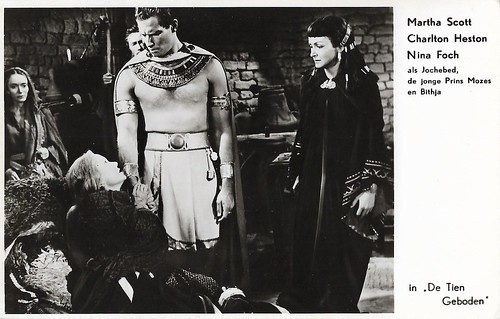
Dutch postcard. Photo: Charlton Heston, Nina Foch, and Martha Scott in The Ten Commandments (Cecil B. DeMille, 1956), released in Dutch as De Tien Geboden.
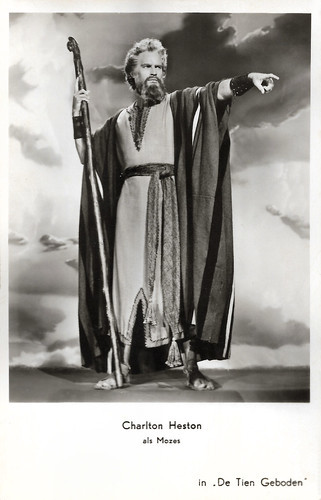
Dutch postcard by Gebr. Spanjersberg N.V., Rotterdam, no. 5183. Photo: Paramount. Publicity still for The Ten Commandments (Cecil B. DeMille, 1956) with Charlton Heston as Moses. Moses' robe was hand-woven by Dorothea Hulse, one of the world's finest weavers. She also created costumes for The Robe, as well as textiles and costume fabrics for Samson and Delilah, David and Bathsheba, and others.
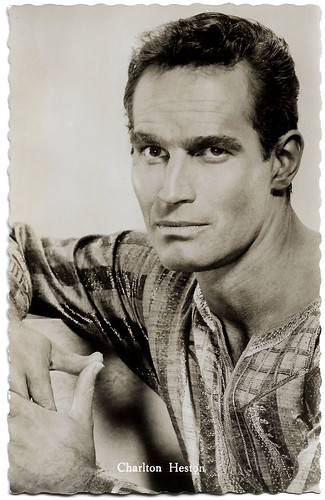
German postcard by Kolibri-Verlag, Minden-Westf., no. 451. Photo: M.G.M. Charlton Heston in Ben-Hur (William Wyler, 1959).
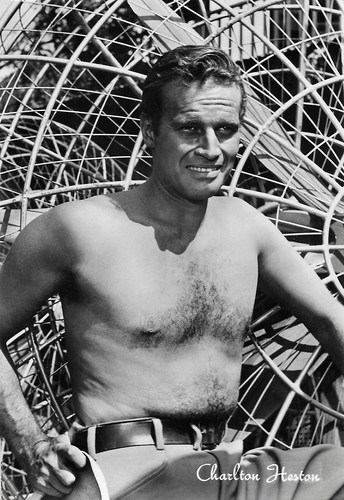
Italian postcard by Rotalfoto, Milano, no. 648.
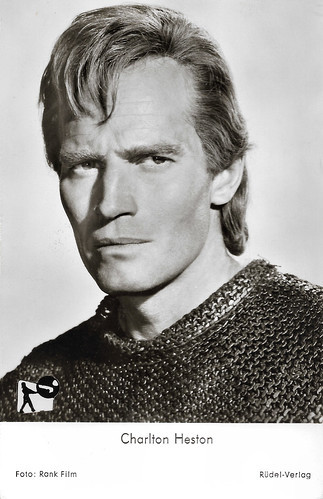
German postcard by Rüdel-Verlag, Hamburg-Bergedorf, no. 3632. Photo: Rank-Film. Publicity still for El Cid (Anthony Mann, 1961).
Embodying responsibility, individualism and masculinity
During the 1960s, Charlton Heston remained the preferred choice of directors to lead the cast in major historical productions. These starring roles gave the actor a grave, authoritative persona and embodied responsibility, individualism and masculinity. Heston rejected scripts that did not emphasise those virtues.
He starred as Spanish legend Rodrigo Diaz de Vivar in El Cid (Anthony Mann, 1961), opposite Sophia Loren. The film, shot in Spain, was a big success. Heston was a US soldier battling hostile Chinese boxers during 55 Days at Peking (Nicholas Ray, 1963) with Ava Gardner , played the ill-fated John the Baptist in The Greatest Story Ever Told (George Stevens, 1965), painter Michelangelo battling Pope Julius II (Rex Harrison) in The Agony and the Ecstasy (Carol Reed, 1965), and an English general in Khartoum (Basil Dearden, 1966) opposite Laurence Olivier .
Heston liked the Western genre. In 1968, Heston filmed the unusual western Will Penny (Tom Gries, 1968) about an ageing and lonely cowboy befriending a lost woman (Joan Hackett) and her son. The picture was based upon an episode of the 1960 Sam Peckinpah television series The Westerner called Line Camp, also written and directed by Tom Gries. The film was not a box office hit, but received excellent reviews. Heston referred to the film as his favourite piece of work on screen.
Interestingly, Heston was on the verge of acquiring an entirely new league of fans due to his appearance in four very topical Science Fiction films (all based on popular novels) painting bleak future's for mankind. In 1968, Heston starred as time traveling astronaut George Taylor, in the terrific Planet of the Apes (Franklin J. Schaffner, 1968) with it's now legendary conclusion as Heston realises the true horror of his destination. He returned to reprise the role, albeit primarily as a cameo, alongside fellow astronaut James Franciscus in the slightly inferior sequel Beneath the Planet of the Apes (Ted Post, 1970).
Next up, Heston again found himself facing the apocalypse in The Omega Man (Boris Sagal, 1971) as the survivor of a germ plague that has wiped out humanity leaving only bands of psychotic lunatics roaming the cities who seek to kill the uninfected Heston. And fourthly, taking its inspiration from the Harry Harrison novel 'Make Room!, Make Room!', Heston starred alongside screen legend Edward G. Robinson and Chuck Connors in Soylent Green (Richard Fleischer, 1973).
During the remainder of the 1970s, Heston appeared in two very popular Disaster films contributing lead roles in the far fetched Airport 1975 (Jack Smight, 1974), plus in the star laden Earthquake (Mark Robson, 1974), filmed in Sensurround (low bass speakers were installed in selected theatres to simulate the earthquake rumblings on screen to film audiences).
Heston played the evil Cardinal Richelieu in the lively The Three Musketeers (Richard Lester, 1973) and the sequel The Four Musketeers (Richard Lester, 1974), starring Michael York and Oliver Reed. He was a mythical US naval officer in the recreation of Battle of Midway (1976), also filmed in Sensurround, an LA cop trying to stop a sniper in Two-Minute Warning (Larry Peerce, 1976) and another US naval officer in the submarine thriller Gray Lady Down (David Greene, 1978).
Heston appeared in numerous episodes of the high rating TV series Dynasty (1981) and The Colbys (1985), before moving onto a mixed bag of projects including TV adaptations of A Man for All Seasons (Charlton Heston, 1988) with Vanessa Redgrave and John Gielgud , and Treasure Island (Fraser Clarke Heston, 1990) with Christian Bale, and hosting two episodes of the comedy show, Saturday Night Live (1975). In the cinema he appeared in cameos as the Good Actor bringing love struck Mike Myers to tears in Wayne's World 2 (Stephen Surjik, 1993), and as the eye patch wearing boss of intelligence agent Arnold Schwarzenegger in True Lies (James Cameron, 1994).
Heston was a supporter of Democratic politicians and civil rights in the 1960s, and volunteered his time and effort to the Civil Rights movement. He even marched alongside the Rev. Dr. Martin Luther King Jr. on a number of occasions, including the 1963 March on Washington. Eventually he rejected liberalism, and founded a conservative political action committee.
Heston campaigned for Republican presidential candidates Ronald Reagan in 1984, George Bush in 1988, George W. Bush in 2000, and Republican candidate for governor of Virginia George Allen in 1993. He was president of the Screen Actors Guild from 1966 to 1971. Heston's most famous role in politics came as the five-term president of the National Rifle Association from 1998 to 2003. Though often portrayed as an ultra-conservative, Heston wrote in his 1995 autobiography 'In the Arena' that he was opposed to the McCarthy witch hunts of the 1950s, was against the Vietnam War and thought President Richard Nixon was bad for America.
In 2001, Heston made a cameo appearance as Gen. Thade's father, an elderly, dying chimpanzee in Tim Burton's remake of Planet of the Apes (2001). His last film appearance was as the infamous Nazi war criminal Dr. Josef Mengele in the Holocaust themed drama My Father, Rua Alguem 5555 (Egidio Eronico, 2003) with Thomas Kretschmann as his son.
In 2002, Charlton Heston was diagnosed with Alzheimer's disease. A frail-looking Heston was presented with a Presidential Medal of Freedom, the nation's highest civilian award, at the White House by George W. Bush in July, 2003. He died in 2008. Heston and his wife Lydia had two children, director Fraser C. Heston and Holly Heston Rochell.
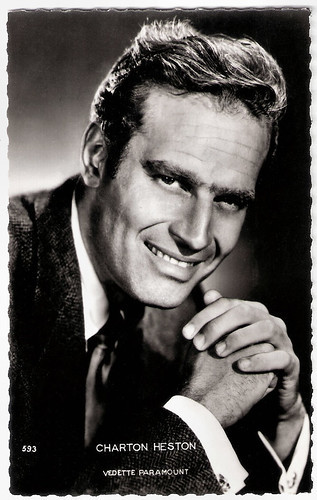
French postcard by Editions P.I., offered by Les Carbones Korès 'Carboplane', no. 593. Photo: Paramount, 1953.
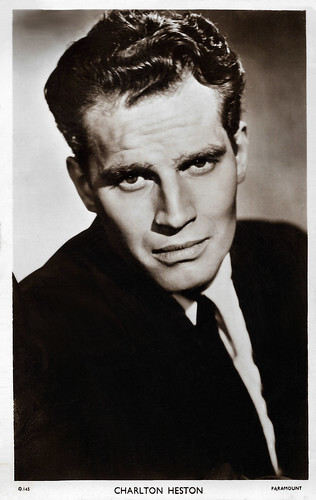
British postcard in the Picturegoer Series, London, no. D 145. Photo: Paramount.
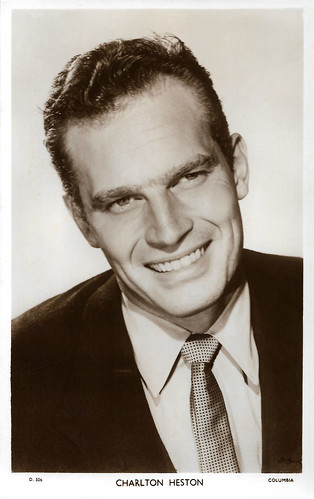
British postcard in the Picturegoer Series, London, no. D 506. Photo: Columbia.
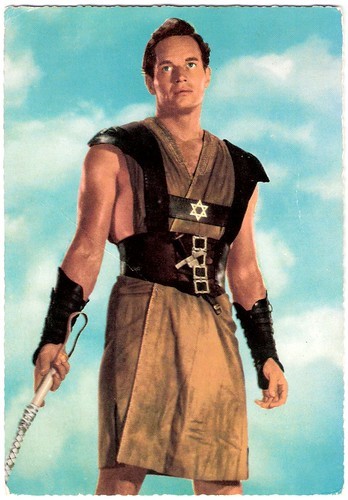
German postcard by ISV, no. E 29. Photo: MGM. Publicity still for Ben-Hur (1959).
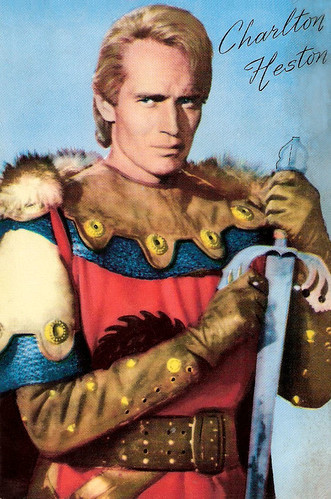
Dutch postcard, no. 143. Photo: publicity still for El Cid (Anthony Mann, 1961).
Sources: Wikipedia and .

Israelian postcard by Editions de Luxe.

French postcard by E.D.U.G., presented by Corvisart, Epinal, no. 252. Photo: Charlton Heston in Ben-Hur (William Wyler, 1959).

French postcard by E.D.U.G., no. 125. Photo: publicity still for Ben-Hur (William Wyler, 1959).

Italian postcard by Rotalcolor, Milano, no. N. 173. Photo: publicity still for El Cid (Anthony Mann, 1961).

Italian postcard. Photo: Dear Film. Charlton Heston, Laurence Olivier and Richard Johnson in Khartoum (Basil Dearden, Eliot Elisofon, 1965).
A tall, tweedy, rough-hewn sort of chap
Charlton Heston was born John Charles Carter in 1924, in Wilmette, Illinois, U.S., to Lila née Baines and Russell Whitford Carter, who operated a sawmill. He had English and Scottish ancestry, with recent Canadian forebears. When Heston was 10 years old, his parents divorced after having three children. Shortly thereafter, his mother remarried Chester Heston.
Charlton and his younger sister Lilla and brother Alan attended New Trier High School in Wilmette. During high school, he enrolled in New Trier's drama program, playing the lead role in a 16mm production of Peer Gynt (1941), based on the Henrik Ibsen play. It was directed by future film activist David Bradley.
From the Winnetka Community Theatre in which he was active, he earned a drama scholarship to Northwestern University; among his acting teachers was Alvina Krause. In 1944, Heston married Northwestern University student Lydia Marie Clarke, who was six months his senior. That same year he enlisted in the United States Army Air Forces. He served for two years as a radio operator and aerial gunner aboard a B-25 Mitchell stationed in the Alaskan Aleutian Islands with the 77th Bombardment Squadron of the Eleventh Air Force. He reached the rank of Staff Sergeant.
After the war, the Hestons lived in Hell's Kitchen, New York City. Heston made ends meet by posing as a model in New York at The Art Students League, across from Carnegie Hall. Seeking a way to make it in theatre, the couple decided to manage a playhouse in Asheville, North Carolina, in 1947, making $100 a week.
In 1948, they returned to New York, where Heston was offered a supporting role in a Broadway revival of William Shakespeare's 'Antony and Cleopatra', starring Katharine Cornell. In television, Heston played a number of roles in CBS's Studio One, one of the most popular anthology dramas of the 1950s. These included a part as Marc Antony in a televised production of Julius Caesar (1950). He was unable to use his real name, John Carter as an actor because it bore too close a resemblance to the name of the hero in Edgar Rice Burroughs' novel 'Princess of Mars'. His professional name of Charlton Heston came from a combination of Charlton was his maternal grandmother Marian's maiden name, and his stepfather's last name.
Film producer Hal B. Wallis of Casablanca (Michael Curtiz, 1942) spotted Heston in a 1950 television production of Wuthering Heights and offered him a contract. When his wife reminded Heston they had decided to pursue theatre and television, he replied, "Well, maybe just for one film to see what it's like." In 1950, he made his feature film debut in the Film Noir Dark City (William Dieterle, 1950) opposite Lizabeth Scott and Viveca Lindfors .
Bosley Crowther, film critic for The New York Times, applauded the work of the newcomer: "A new star named Charlton Heston — a tall, tweedy, rough-hewn sort of chap who looks like a triple-threat halfback on a midwestern college football team—is given an unfortunate send-off on the low and lurid level of crime in Hal Wallis' thriller, Dark City, which came to the Paramount yesterday. Apparently Mr. Heston, who has worked for the stage and video, has something more than appearance to recommend him to dramatic roles. He has a quiet but assertive magnetism, a youthful dignity and a plainly potential sense of timing that is the good actor's sine qua non. But in this 'clutching hand' chiller, he is called upon to play nothing more complex or demanding than a crooked gambler marked for doom."
Heston's breakthrough came when Cecil B. DeMille cast him as as circus manager 'Brad Braden' in the spectacular epic The Greatest Show on Earth (Cecil B. DeMille, 1952), also starring James Stewart and Cornel Wilde. The film was named by the Motion Picture Academy as the Best Picture of 1952. It was also the most popular film of that year.
The now very popular actor remained perpetually busy during the next years, both on TV and in the cinema. King Vidor used Heston in a melodrama with Jennifer Jones, Ruby Gentry (1952). He pleased audiences again in the steamy thriller Marabunta (Byron Haskin, 1954) with Eleanor Parker, and as a treasure hunter in Secret of the Incas (Jerry Hopper, 1954). Shot on location at Machu Picchu in Peru, the film is often credited as the inspiration for Raiders of the Lost Ark (Steven Spielberg, 1981).
Heston became an icon for portraying Moses in the blockbuster The Ten Commandments (Cecil B. DeMille, 1956). According to DeMille, Heston bore an uncanny resemblance to the statue of Moses carved by Michelangelo. The Hollywood Reporter described him as "splendid, handsome and princely (and human) in the scenes dealing with him as a young man, and majestic and terrible as his role demands it". For his role, Heston received his first Golden Globe Award nomination.
Furthermore, he is known for his dynamic Mexican narcotics officer Miguel 'Mike' Vargas in Orson Welles ' widely acclaimed Film Noir Touch of Evil (Orson Welles, 1958), and for his rare supporting role alongside Gregory Peck in the Western The Big Country (William Wyler, 1958).
Then followed his best known role as the wronged Jewish prince who seeks his freedom and revenge in Ben-Hur (William Wyler, 1959), for which he won the Oscar for Best Actor. It was one of the unprecedented 11 Oscars the film earned. This Biblical epic became the standard by which other large scale productions would be judged. It's superb cast also included Stephen Boyd as the villainous Massala, and English actor Jack Hawkins as the Roman officer Quintus Arrius.

Dutch postcard. Photo: Charlton Heston, Nina Foch, and Martha Scott in The Ten Commandments (Cecil B. DeMille, 1956), released in Dutch as De Tien Geboden.

Dutch postcard by Gebr. Spanjersberg N.V., Rotterdam, no. 5183. Photo: Paramount. Publicity still for The Ten Commandments (Cecil B. DeMille, 1956) with Charlton Heston as Moses. Moses' robe was hand-woven by Dorothea Hulse, one of the world's finest weavers. She also created costumes for The Robe, as well as textiles and costume fabrics for Samson and Delilah, David and Bathsheba, and others.

German postcard by Kolibri-Verlag, Minden-Westf., no. 451. Photo: M.G.M. Charlton Heston in Ben-Hur (William Wyler, 1959).

Italian postcard by Rotalfoto, Milano, no. 648.

German postcard by Rüdel-Verlag, Hamburg-Bergedorf, no. 3632. Photo: Rank-Film. Publicity still for El Cid (Anthony Mann, 1961).
Embodying responsibility, individualism and masculinity
During the 1960s, Charlton Heston remained the preferred choice of directors to lead the cast in major historical productions. These starring roles gave the actor a grave, authoritative persona and embodied responsibility, individualism and masculinity. Heston rejected scripts that did not emphasise those virtues.
He starred as Spanish legend Rodrigo Diaz de Vivar in El Cid (Anthony Mann, 1961), opposite Sophia Loren. The film, shot in Spain, was a big success. Heston was a US soldier battling hostile Chinese boxers during 55 Days at Peking (Nicholas Ray, 1963) with Ava Gardner , played the ill-fated John the Baptist in The Greatest Story Ever Told (George Stevens, 1965), painter Michelangelo battling Pope Julius II (Rex Harrison) in The Agony and the Ecstasy (Carol Reed, 1965), and an English general in Khartoum (Basil Dearden, 1966) opposite Laurence Olivier .
Heston liked the Western genre. In 1968, Heston filmed the unusual western Will Penny (Tom Gries, 1968) about an ageing and lonely cowboy befriending a lost woman (Joan Hackett) and her son. The picture was based upon an episode of the 1960 Sam Peckinpah television series The Westerner called Line Camp, also written and directed by Tom Gries. The film was not a box office hit, but received excellent reviews. Heston referred to the film as his favourite piece of work on screen.
Interestingly, Heston was on the verge of acquiring an entirely new league of fans due to his appearance in four very topical Science Fiction films (all based on popular novels) painting bleak future's for mankind. In 1968, Heston starred as time traveling astronaut George Taylor, in the terrific Planet of the Apes (Franklin J. Schaffner, 1968) with it's now legendary conclusion as Heston realises the true horror of his destination. He returned to reprise the role, albeit primarily as a cameo, alongside fellow astronaut James Franciscus in the slightly inferior sequel Beneath the Planet of the Apes (Ted Post, 1970).
Next up, Heston again found himself facing the apocalypse in The Omega Man (Boris Sagal, 1971) as the survivor of a germ plague that has wiped out humanity leaving only bands of psychotic lunatics roaming the cities who seek to kill the uninfected Heston. And fourthly, taking its inspiration from the Harry Harrison novel 'Make Room!, Make Room!', Heston starred alongside screen legend Edward G. Robinson and Chuck Connors in Soylent Green (Richard Fleischer, 1973).
During the remainder of the 1970s, Heston appeared in two very popular Disaster films contributing lead roles in the far fetched Airport 1975 (Jack Smight, 1974), plus in the star laden Earthquake (Mark Robson, 1974), filmed in Sensurround (low bass speakers were installed in selected theatres to simulate the earthquake rumblings on screen to film audiences).
Heston played the evil Cardinal Richelieu in the lively The Three Musketeers (Richard Lester, 1973) and the sequel The Four Musketeers (Richard Lester, 1974), starring Michael York and Oliver Reed. He was a mythical US naval officer in the recreation of Battle of Midway (1976), also filmed in Sensurround, an LA cop trying to stop a sniper in Two-Minute Warning (Larry Peerce, 1976) and another US naval officer in the submarine thriller Gray Lady Down (David Greene, 1978).
Heston appeared in numerous episodes of the high rating TV series Dynasty (1981) and The Colbys (1985), before moving onto a mixed bag of projects including TV adaptations of A Man for All Seasons (Charlton Heston, 1988) with Vanessa Redgrave and John Gielgud , and Treasure Island (Fraser Clarke Heston, 1990) with Christian Bale, and hosting two episodes of the comedy show, Saturday Night Live (1975). In the cinema he appeared in cameos as the Good Actor bringing love struck Mike Myers to tears in Wayne's World 2 (Stephen Surjik, 1993), and as the eye patch wearing boss of intelligence agent Arnold Schwarzenegger in True Lies (James Cameron, 1994).
Heston was a supporter of Democratic politicians and civil rights in the 1960s, and volunteered his time and effort to the Civil Rights movement. He even marched alongside the Rev. Dr. Martin Luther King Jr. on a number of occasions, including the 1963 March on Washington. Eventually he rejected liberalism, and founded a conservative political action committee.
Heston campaigned for Republican presidential candidates Ronald Reagan in 1984, George Bush in 1988, George W. Bush in 2000, and Republican candidate for governor of Virginia George Allen in 1993. He was president of the Screen Actors Guild from 1966 to 1971. Heston's most famous role in politics came as the five-term president of the National Rifle Association from 1998 to 2003. Though often portrayed as an ultra-conservative, Heston wrote in his 1995 autobiography 'In the Arena' that he was opposed to the McCarthy witch hunts of the 1950s, was against the Vietnam War and thought President Richard Nixon was bad for America.
In 2001, Heston made a cameo appearance as Gen. Thade's father, an elderly, dying chimpanzee in Tim Burton's remake of Planet of the Apes (2001). His last film appearance was as the infamous Nazi war criminal Dr. Josef Mengele in the Holocaust themed drama My Father, Rua Alguem 5555 (Egidio Eronico, 2003) with Thomas Kretschmann as his son.
In 2002, Charlton Heston was diagnosed with Alzheimer's disease. A frail-looking Heston was presented with a Presidential Medal of Freedom, the nation's highest civilian award, at the White House by George W. Bush in July, 2003. He died in 2008. Heston and his wife Lydia had two children, director Fraser C. Heston and Holly Heston Rochell.

French postcard by Editions P.I., offered by Les Carbones Korès 'Carboplane', no. 593. Photo: Paramount, 1953.

British postcard in the Picturegoer Series, London, no. D 145. Photo: Paramount.

British postcard in the Picturegoer Series, London, no. D 506. Photo: Columbia.

German postcard by ISV, no. E 29. Photo: MGM. Publicity still for Ben-Hur (1959).

Dutch postcard, no. 143. Photo: publicity still for El Cid (Anthony Mann, 1961).
Sources: Wikipedia and .
Published on May 30, 2019 22:00
May 29, 2019
Michelle Pfeiffer
American actress and producer Michelle Pfeiffer (1958) was one of the most popular and talented Hollywood actresses of the 1980s and 1990s. Her rare beauty inspired countless platitudes and an almost-permanent place on People's Fifty Most Beautiful list. But Pfeiffer has since become particularly known for portraying nuanced and unglamorous, emotionally distant women as well as strong female characters with intense sex appeal.
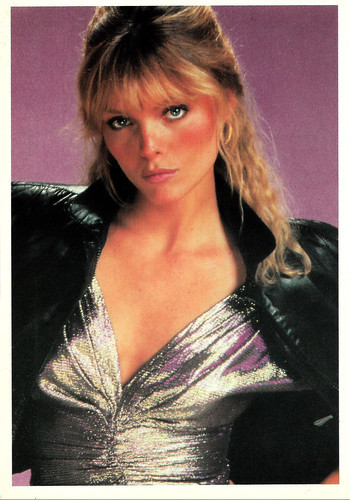
Spanish postcard in the Collección 'Estrellas cinematográficas', by CACITEL, no. 44, 1990. Michelle Pfeiffer in Grease 2 (Patricia Birch, 1982).
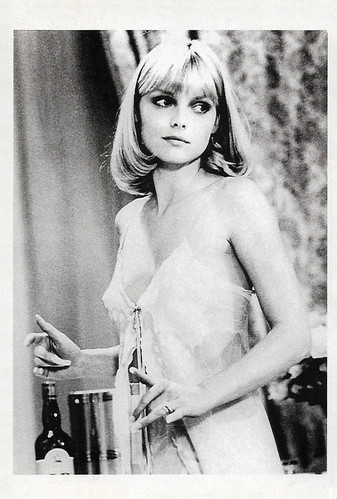
Vintage postcard, no. pc0468. Michelle Pfeiffer in Scarface (Brian De Palma, 1983).
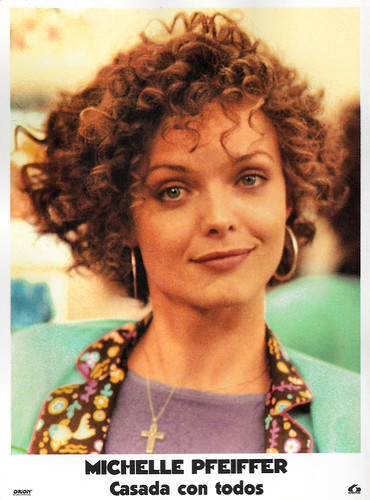
Spanish postcard in the 'Yo amo al cine' Series by Novograf / Lauren Films. Photo: Orion Pictures International / Lauren Films. Publicity still for Married to the Mob (Jonathan Demme, 1988).
A sultry lounge singer
Michelle Marie Pfeiffer was born in 1958 in Santa Ana, California, to Donna Jean (Taverna) and Richard Pfeiffer, a heating and air-conditioning contractor. She graduated from Fountain Valley High School in 1976, and attended one year at the Golden West College, where she studied to become a court reporter. But at age 19, while working as a supermarket checker at Vons, a large Southern California grocery chain, she had an epiphany of sorts while a woman was complaining about the cantaloupe. She entered a beauty contest, seeking a ticket out of retail.
In 1978, Pfeiffer won the Miss Orange County beauty pageant, and participated in the Miss California contest the same year, finishing in sixth place. She auditioned for commercials and modeling assignments while she attended acting school. She made her acting debut in a one-line role on the TV series Fantasy Island (1978), and played several other minor roles in television series and films.
Her first leading role was in the musical film Grease 2 (Patricia Birch, 1982) opposite Maxwell Caulfield. It was the sequel to the popular hit film Grease (Randal Kleiser, 1978) and takes place two years after the original film at Rydell High School, set in the 1961–1962 school year. Although the film was poorly received, it increased public interest in Pfeiffer.
On her early screen roles, she asserted in a 1995 interview in The New York Times: "I needed to learn how to act ... in the meantime, I was playing bimbos and cashing in on my looks." Frustrated with being typecast as the token pretty girl, Pfeiffer actively pursued more serious material. She received strong reviews for her breakout performance as cocaine-addicted trophy wife Elvira Hancock in the crime film Scarface (Brian De Palma, 1983) opposite Al Pacino. The violent film became a commercial hit and gained a large cult following over the years.
Following Scarface, she played Diana in John Landis' comedy Into the Night (1985), with Jeff Goldblum, Isabeau d'Anjou in Richard Donner's fantasy adventure Ladyhawke (1985), with Rutger Hauer and Matthew Broderick. Her performance as one of the three women bedevilled by Jack Nicholson - the other two being Cher and Susan Sarandon - in the dark fantasy The Witches of Eastwick (George Miller, 1987) proved to be one of her first box office successes.
Pfeiffer then was cast against type as a murdered mobster's widow in the Mafia comedy Married to the Mob (Jonathan Demme, 1988). For the role of big-haired and gum-smacking Angela de Marco, she donned a curly brunette wig and a Brooklyn accent. She received her first Golden Globe Award nomination as Best Actress in a Motion Picture Musical or Comedy, beginning a six-year streak of consecutive Best Actress nominations at the Golden Globes.
In Dangerous Liaisons (Stephen Frears, 1988) based on Christopher Hampton's play Les liaisons dangereuses, she played the virtuous victim of seduction, Madame Marie de Tourvel, opposite with Glenn Close and John Malkovich. Her role garnered her an Academy Award nomination for Best Supporting Actress.
Then followed her sultry performance as a hard-edged former call girl turned lounge singer, Susie Diamond in The Fabulous Baker Boys (Steve Kloves, 1989) with Jeff and Beau Bridges. She underwent intensive voice training for the role for four months, and performed all of her character's vocals. Classic is her scene in which the lounge singer drapes herself over a piano cooing a heart-stopping rendition of 'Making Whoopee'. Susie would be the most critically acclaimed role of her career and she got another Academy Award nomination, now for Best Actress.
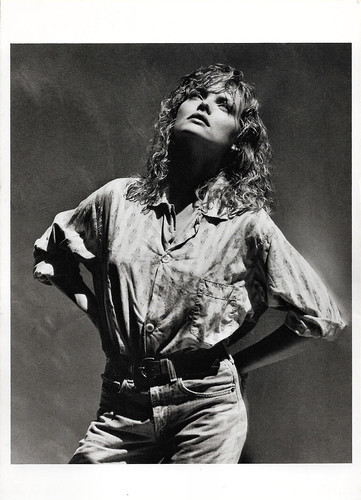
American postcard by Fotofolio, N.Y. Photo: Greg Gorman. Caption: Michelle Pfeiffer, Los Angeles, 1988.
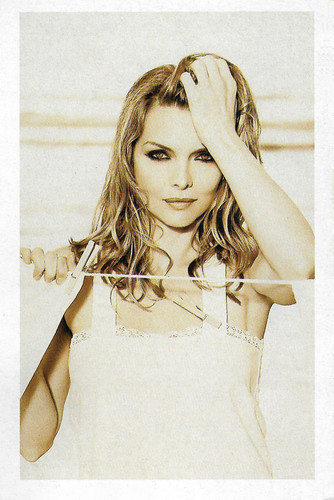
Belgian postcard in de 'De 50 mooiste vrouwen van de eeuw' (The 50 most beautiful women of the century) series by P magazine, no. 17. Photo: Visages.
The definitive portrayal of Catwoman
In 1981, Michelle Pfeiffer had married actor/director Peter Horton, known as Gary in the television series Thirtysomething. They were later divorced, and she then had a three year relationship with actor Fisher Stevens. When that did not work out, Pfeiffer decided she did not want to wait any longer before having her own family, and in March 1993, she adopted a baby girl, Claudia Rose. Later the same year, she married lawyer-turned-writer/producer David E. Kelley, creator of such series as Ally McBeal and Boston Legal. In 1994, their son John Henry was born.
The 1990s proved to be a good decade for Pfeiffer. She starred opposite Al Pacino as the mousy, severely damaged waitress Frankie in the romantic comedy Frankie and Johnny (Garry Marshall, 1991). She achieved widespread recognition as Catwoman / Selina Kyle in Tim Burton's superhero film Batman Returns (1992). For the role, she trained in martial arts and kickboxing. Her stitched-together, black patent leather costume, based on a sketch of Burton's, remains the character's most iconic look, and Pfeiffer's growling, fierce performance is widely regarded as one of the most definitive portrayals of the comic book character.
She earned a third Academy Award nomination for her role as a frustrated housewife in the virtually unseen Love Field (Jonathan Kaplan, 1992), before starring in the critically acclaimed The Age of Innocence (Martin Scorsese, 1993) with Daniel Day Lewis. She portrayed a Countess in upper-class New York City in the 1870s. It was followed by the romantic horror film Wolf (Mike Nichols, 1994) with Jack Nicholson, the supernatural horror film What Lies Beneath (Robert Zemeckis, 2000) with Harrison Ford, and White Oleander (Peter Kosminsky, 2002). From 1990 till 1999 she also produced a series of films under her production company Via Rosa Productions.
After a five-year hiatus from film acting in order to spend more quality time with her children and family, Pfeiffer appeared in Hairspray (Adam Shankman, 2007), the film adaptation of the Broadway musical of the same name. She starred with John Travolta, Christopher Walken, Zac Efron and Queen Latifah, in the role of Velma Von Tussle, the racist manager of a television station.
Then followed Colette's Chéri (Stephen Frears, 2009), as ageing retired courtesan Léa de Lonval, with Rupert Friend in the title role, and Kathy Bates as his mother. Pfeiffer reunited with Tim Burton in Dark Shadows (Tim Burton, 2012), based on the Gothic television soap opera of the same name. In the film, co-starring Johnny Depp, Eva Green, and Helena Bonham Carter, she played Elizabeth Collins Stoddard, the stern and strict, but loyal and devoted family matriarch.
Recently, Michelle Pfeiffer received her first Emmy Award nomination for portraying Ruth Madoff in the HBO television film The Wizard of Lies (Barry Levinson, 2017). Robert De Niro played her husband, disgraced financier Bernard Madoff. She garnered further critical acclaim for her role in Where Is Kyra? (Andrew Dosunmu, 2017) with Kiefer Sutherland. Pfeiffer also appeared in the ensemble films Murder on the Orient Express (Kenneth Branagh, 2017) and Ant-Man and the Wasp (Peyton Reed, 2018). Later this year, she can be seen in the superhero film Avengers: Endgame (Joe Russo, Anthony Russo, 2019).

Belgian postcard by Multichoice. Photo: Isopress / Outline (Deborah Feingold).
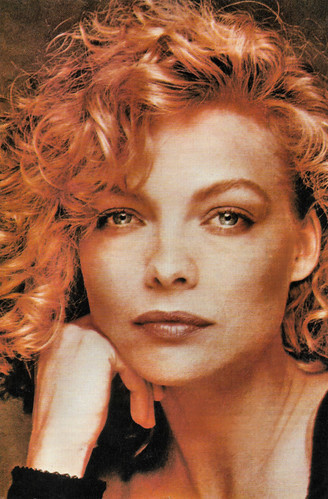
Romanian postcard by Publiturism / Inter Contempress.
Sources: Tim Egan (The New York Times), Rebecca Flint Marx (AllMovie), Wikipedia and .

Spanish postcard in the Collección 'Estrellas cinematográficas', by CACITEL, no. 44, 1990. Michelle Pfeiffer in Grease 2 (Patricia Birch, 1982).

Vintage postcard, no. pc0468. Michelle Pfeiffer in Scarface (Brian De Palma, 1983).

Spanish postcard in the 'Yo amo al cine' Series by Novograf / Lauren Films. Photo: Orion Pictures International / Lauren Films. Publicity still for Married to the Mob (Jonathan Demme, 1988).
A sultry lounge singer
Michelle Marie Pfeiffer was born in 1958 in Santa Ana, California, to Donna Jean (Taverna) and Richard Pfeiffer, a heating and air-conditioning contractor. She graduated from Fountain Valley High School in 1976, and attended one year at the Golden West College, where she studied to become a court reporter. But at age 19, while working as a supermarket checker at Vons, a large Southern California grocery chain, she had an epiphany of sorts while a woman was complaining about the cantaloupe. She entered a beauty contest, seeking a ticket out of retail.
In 1978, Pfeiffer won the Miss Orange County beauty pageant, and participated in the Miss California contest the same year, finishing in sixth place. She auditioned for commercials and modeling assignments while she attended acting school. She made her acting debut in a one-line role on the TV series Fantasy Island (1978), and played several other minor roles in television series and films.
Her first leading role was in the musical film Grease 2 (Patricia Birch, 1982) opposite Maxwell Caulfield. It was the sequel to the popular hit film Grease (Randal Kleiser, 1978) and takes place two years after the original film at Rydell High School, set in the 1961–1962 school year. Although the film was poorly received, it increased public interest in Pfeiffer.
On her early screen roles, she asserted in a 1995 interview in The New York Times: "I needed to learn how to act ... in the meantime, I was playing bimbos and cashing in on my looks." Frustrated with being typecast as the token pretty girl, Pfeiffer actively pursued more serious material. She received strong reviews for her breakout performance as cocaine-addicted trophy wife Elvira Hancock in the crime film Scarface (Brian De Palma, 1983) opposite Al Pacino. The violent film became a commercial hit and gained a large cult following over the years.
Following Scarface, she played Diana in John Landis' comedy Into the Night (1985), with Jeff Goldblum, Isabeau d'Anjou in Richard Donner's fantasy adventure Ladyhawke (1985), with Rutger Hauer and Matthew Broderick. Her performance as one of the three women bedevilled by Jack Nicholson - the other two being Cher and Susan Sarandon - in the dark fantasy The Witches of Eastwick (George Miller, 1987) proved to be one of her first box office successes.
Pfeiffer then was cast against type as a murdered mobster's widow in the Mafia comedy Married to the Mob (Jonathan Demme, 1988). For the role of big-haired and gum-smacking Angela de Marco, she donned a curly brunette wig and a Brooklyn accent. She received her first Golden Globe Award nomination as Best Actress in a Motion Picture Musical or Comedy, beginning a six-year streak of consecutive Best Actress nominations at the Golden Globes.
In Dangerous Liaisons (Stephen Frears, 1988) based on Christopher Hampton's play Les liaisons dangereuses, she played the virtuous victim of seduction, Madame Marie de Tourvel, opposite with Glenn Close and John Malkovich. Her role garnered her an Academy Award nomination for Best Supporting Actress.
Then followed her sultry performance as a hard-edged former call girl turned lounge singer, Susie Diamond in The Fabulous Baker Boys (Steve Kloves, 1989) with Jeff and Beau Bridges. She underwent intensive voice training for the role for four months, and performed all of her character's vocals. Classic is her scene in which the lounge singer drapes herself over a piano cooing a heart-stopping rendition of 'Making Whoopee'. Susie would be the most critically acclaimed role of her career and she got another Academy Award nomination, now for Best Actress.

American postcard by Fotofolio, N.Y. Photo: Greg Gorman. Caption: Michelle Pfeiffer, Los Angeles, 1988.

Belgian postcard in de 'De 50 mooiste vrouwen van de eeuw' (The 50 most beautiful women of the century) series by P magazine, no. 17. Photo: Visages.
The definitive portrayal of Catwoman
In 1981, Michelle Pfeiffer had married actor/director Peter Horton, known as Gary in the television series Thirtysomething. They were later divorced, and she then had a three year relationship with actor Fisher Stevens. When that did not work out, Pfeiffer decided she did not want to wait any longer before having her own family, and in March 1993, she adopted a baby girl, Claudia Rose. Later the same year, she married lawyer-turned-writer/producer David E. Kelley, creator of such series as Ally McBeal and Boston Legal. In 1994, their son John Henry was born.
The 1990s proved to be a good decade for Pfeiffer. She starred opposite Al Pacino as the mousy, severely damaged waitress Frankie in the romantic comedy Frankie and Johnny (Garry Marshall, 1991). She achieved widespread recognition as Catwoman / Selina Kyle in Tim Burton's superhero film Batman Returns (1992). For the role, she trained in martial arts and kickboxing. Her stitched-together, black patent leather costume, based on a sketch of Burton's, remains the character's most iconic look, and Pfeiffer's growling, fierce performance is widely regarded as one of the most definitive portrayals of the comic book character.
She earned a third Academy Award nomination for her role as a frustrated housewife in the virtually unseen Love Field (Jonathan Kaplan, 1992), before starring in the critically acclaimed The Age of Innocence (Martin Scorsese, 1993) with Daniel Day Lewis. She portrayed a Countess in upper-class New York City in the 1870s. It was followed by the romantic horror film Wolf (Mike Nichols, 1994) with Jack Nicholson, the supernatural horror film What Lies Beneath (Robert Zemeckis, 2000) with Harrison Ford, and White Oleander (Peter Kosminsky, 2002). From 1990 till 1999 she also produced a series of films under her production company Via Rosa Productions.
After a five-year hiatus from film acting in order to spend more quality time with her children and family, Pfeiffer appeared in Hairspray (Adam Shankman, 2007), the film adaptation of the Broadway musical of the same name. She starred with John Travolta, Christopher Walken, Zac Efron and Queen Latifah, in the role of Velma Von Tussle, the racist manager of a television station.
Then followed Colette's Chéri (Stephen Frears, 2009), as ageing retired courtesan Léa de Lonval, with Rupert Friend in the title role, and Kathy Bates as his mother. Pfeiffer reunited with Tim Burton in Dark Shadows (Tim Burton, 2012), based on the Gothic television soap opera of the same name. In the film, co-starring Johnny Depp, Eva Green, and Helena Bonham Carter, she played Elizabeth Collins Stoddard, the stern and strict, but loyal and devoted family matriarch.
Recently, Michelle Pfeiffer received her first Emmy Award nomination for portraying Ruth Madoff in the HBO television film The Wizard of Lies (Barry Levinson, 2017). Robert De Niro played her husband, disgraced financier Bernard Madoff. She garnered further critical acclaim for her role in Where Is Kyra? (Andrew Dosunmu, 2017) with Kiefer Sutherland. Pfeiffer also appeared in the ensemble films Murder on the Orient Express (Kenneth Branagh, 2017) and Ant-Man and the Wasp (Peyton Reed, 2018). Later this year, she can be seen in the superhero film Avengers: Endgame (Joe Russo, Anthony Russo, 2019).

Belgian postcard by Multichoice. Photo: Isopress / Outline (Deborah Feingold).

Romanian postcard by Publiturism / Inter Contempress.
Sources: Tim Egan (The New York Times), Rebecca Flint Marx (AllMovie), Wikipedia and .
Published on May 29, 2019 22:00
May 28, 2019
Der Todessprung (1919)
Fern Andra (1893-1974) was one of the most popular film stars of the German cinema in the 1910s and early 1920s. In her films, she mastered tightrope walking, riding a horse without a saddle, driving cars and motorcycles, bob sleighing, and even boxing. In her own production Der Todessprung/Um Krone und Peitsche/Crown and Whip (1919), Andra makes a spectacular death leap with her circus horse.
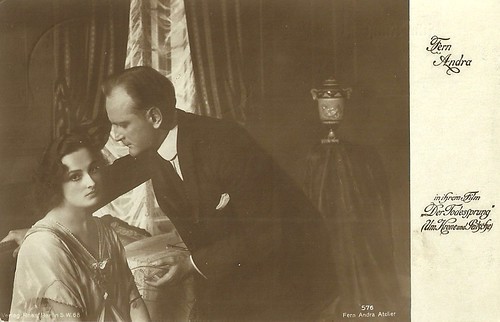
German postcard by Ross Verlag, no. 576. Photo: Fern-Andra-Atelier. Fern Andra and Josef Peterhans in Der Todessprung/Um Krone und Peitsche/Crown and Whip (Georg Bluen, Fern Andra, 1919).
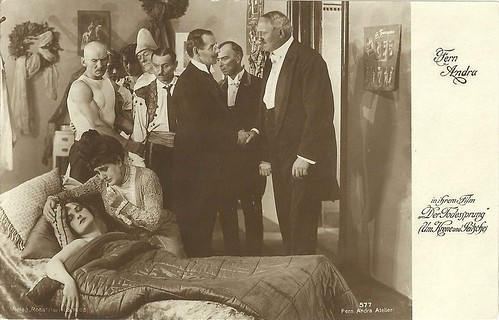
German postcard by Ross Verlag, no. 577. Photo: Fern-Andra-Atelier. Fern Andra , probably Olga Engl and Wilhelm Diegelmann in Der Todessprung/Um Krone und Peitsche/Crown and Whip (Georg Bluen, Fern Andra, 1919).
A Free-spirited Circus Princess
The circus melodrama Der Todessprung/Um Krone und Peitsche/Crown and Whip (Georg Bluen, Fern Andra, 1919) is based on a novel by Jean Kolzer. Fern Andra plays a circus rider who is an artist with heart and soul. One day she meets Count von Wallenberg (Josef Peterhans) and both fall in love with each other. When he has risen to become a major, Egon asks for her hand. She accepts his proposal and they marry.
The joyful, free-spirited circus rider, embarrassed by no open word, soon becomes the object of snobbery among her husband's friends and a thorn in the side of the lordly mother-in-law, the old countess (Olga Engl). The old woman begins to intrigue against her.
Soon her intrigues succeed. When Count von Wallenberg gets into a duel to defend his honour, he is imprisoned for six months. His mother and his old girl friend take this opportunity to set his wife packing. The young woman returns to the circus and resumes her old job. Back home, Egon is deeply saddened that his wife has left him. His mother, who once gave the cause to break the two, then decides to bring Egon and his circus princess together again.
Fern Andra co-directed and produced Der Todessprung/Um Krone und Peitsche/Crown and Whip (1919). In January 1919, the film premiered at the Marmorhaus, one of the most prestigious movie palaces in Berlin.
Bob Lipton at IMDb : "It's an old story told in old-fashioned cinematic technique and, except for the circus scenes - Germans were very fond of movies involving circus people - this is a vehicle for Miss Andra to suffer in. She had been born in Illinois in 1893. Her entrance into show business was as a circus aerialist. While touring in Europe, she became a student of Max Reinhardt and soon went into the movies. With the outbreak of the First World War, she was suspected as a spy. She allayed these fears by marrying her first husband, a German baron who was killed during the War; this gave her a fine cover to spy for the Allies."
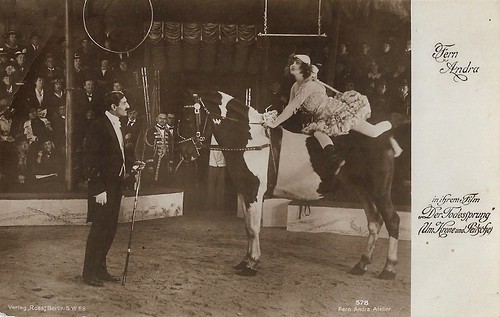
German postcard by Ross Verlag, no. 578. Photo: Fern-Andra-Atelier. Fern Andra in Der Todessprung/Um Krone und Peitsche/Crown and Whip (Georg Bluen, Fern Andra, 1919).
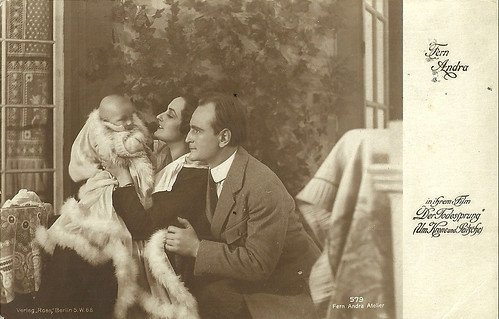
German postcard by Ross Verlag, no. 579. Photo: Fern-Andra-Atelier. Fern Andra and Josef Peterhans in Der Todessprung/Um Krone und Peitsche/Crown and Whip (Georg Bluen, Fern Andra, 1919).
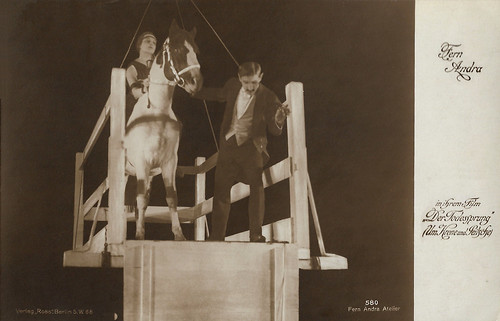
German postcard by Ross Verlag, no. 580. Photo: Fern-Andra-Atelier. Fern Andra in Der Todessprung/Um Krone und Peitsche/Crown and Whip (Georg Bluen, Fern Andra, 1919).
Sources: Wikipedia (English and German), and IMDb.

German postcard by Ross Verlag, no. 576. Photo: Fern-Andra-Atelier. Fern Andra and Josef Peterhans in Der Todessprung/Um Krone und Peitsche/Crown and Whip (Georg Bluen, Fern Andra, 1919).

German postcard by Ross Verlag, no. 577. Photo: Fern-Andra-Atelier. Fern Andra , probably Olga Engl and Wilhelm Diegelmann in Der Todessprung/Um Krone und Peitsche/Crown and Whip (Georg Bluen, Fern Andra, 1919).
A Free-spirited Circus Princess
The circus melodrama Der Todessprung/Um Krone und Peitsche/Crown and Whip (Georg Bluen, Fern Andra, 1919) is based on a novel by Jean Kolzer. Fern Andra plays a circus rider who is an artist with heart and soul. One day she meets Count von Wallenberg (Josef Peterhans) and both fall in love with each other. When he has risen to become a major, Egon asks for her hand. She accepts his proposal and they marry.
The joyful, free-spirited circus rider, embarrassed by no open word, soon becomes the object of snobbery among her husband's friends and a thorn in the side of the lordly mother-in-law, the old countess (Olga Engl). The old woman begins to intrigue against her.
Soon her intrigues succeed. When Count von Wallenberg gets into a duel to defend his honour, he is imprisoned for six months. His mother and his old girl friend take this opportunity to set his wife packing. The young woman returns to the circus and resumes her old job. Back home, Egon is deeply saddened that his wife has left him. His mother, who once gave the cause to break the two, then decides to bring Egon and his circus princess together again.
Fern Andra co-directed and produced Der Todessprung/Um Krone und Peitsche/Crown and Whip (1919). In January 1919, the film premiered at the Marmorhaus, one of the most prestigious movie palaces in Berlin.
Bob Lipton at IMDb : "It's an old story told in old-fashioned cinematic technique and, except for the circus scenes - Germans were very fond of movies involving circus people - this is a vehicle for Miss Andra to suffer in. She had been born in Illinois in 1893. Her entrance into show business was as a circus aerialist. While touring in Europe, she became a student of Max Reinhardt and soon went into the movies. With the outbreak of the First World War, she was suspected as a spy. She allayed these fears by marrying her first husband, a German baron who was killed during the War; this gave her a fine cover to spy for the Allies."

German postcard by Ross Verlag, no. 578. Photo: Fern-Andra-Atelier. Fern Andra in Der Todessprung/Um Krone und Peitsche/Crown and Whip (Georg Bluen, Fern Andra, 1919).

German postcard by Ross Verlag, no. 579. Photo: Fern-Andra-Atelier. Fern Andra and Josef Peterhans in Der Todessprung/Um Krone und Peitsche/Crown and Whip (Georg Bluen, Fern Andra, 1919).

German postcard by Ross Verlag, no. 580. Photo: Fern-Andra-Atelier. Fern Andra in Der Todessprung/Um Krone und Peitsche/Crown and Whip (Georg Bluen, Fern Andra, 1919).
Sources: Wikipedia (English and German), and IMDb.
Published on May 28, 2019 22:00
May 27, 2019
Bertram Wallis
Tall and handsome Bertram Wallis (1874-1952) was a renowned English actor and singer. He was a glamorous matinee idol in popular plays and musical comedies of the early 20th century. Between the two wars he also appeared in several British films.
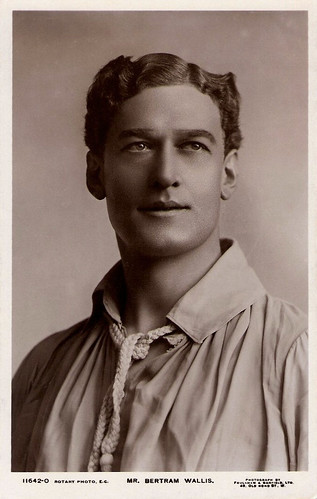
British postcard by Rotary Photo, E.C., no. 11642-0. Photo: Foulsham & Barnfield, Ltd., London.
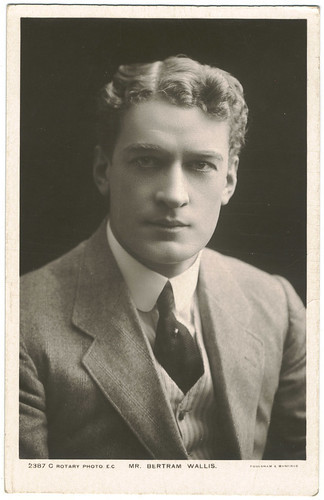
British postcard by Rotary Photo, E.C., no. 2387 C. Photo: Foulsham & Banfield, Ltd., London. Collection: Manuel Palomino Arjona @ Flickr.
Rare Talent
Bertram Wallis was a huge man who stood more than 2 metres tall. He was born in 1874 in London. His parents were Frederick Augustus Wallis and Sarah Mary (née Williams).
Bertram won the Westmorland Scholarship to study voice at the Royal Academy of Music. There he won the Parepa-Rosa gold medal and the Evill Prize.
His first professional engagements were in George Alexander 's production of William Shakespeare’s 'As You Like It' (1896) and in Shakespeare’s 'Much Ado About Nothing' (1898).
In the early years of the 20th century, Wallis had his first successes on the musical stage, such as in 'A Country Girl'. He had the rare talent of being able to sing beautifully and also act superbly.
He then travelled to New York to play in several Broadway productions, including 'A Madcap Princess' (1904), 'Princess Beggar' (1907), and 'Miss Hook of Holland' (1907-1908).
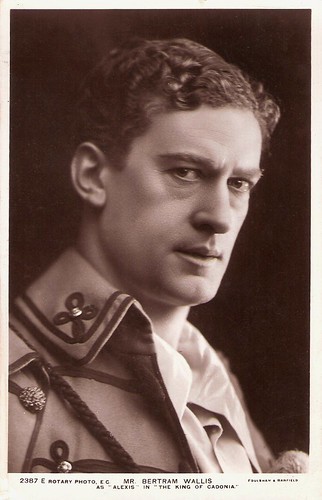
British postcard by Rotary Photo, E.C., no. 2387 E. Photo: Foulsham & Banfield. Publicity still for the play 'The King of Caledonia' (1908).

British postcard by Rotary Photo, E.C., no. 2387 B. Photo: Foulsham & Banfield. Publicity still for the play 'The King of Caledonia' (1908). Collection: Manuel Palomino Arjona @ Flickr.
Glamorous Matinee Idol
Bertram Wallis returned to London and established his career in the operetta 'King of Cadonia'(1908) at the Prince of Wales theatre in the West End. From this point on, he reigned as one of the Edwardian age’s most glamorous matinee idols and one of its biggest male postcard-sellers.
He starred in a number of successful London musicals, often with Isabel Jay or José Collins, including 'Dear Little Denmark'(1909), 'The Balkan Princess' (1910), 'The Count of Luxembourg'(1911), and 'The Happy Day'(1916).
A hit was the revue 'Zig Zag!' (1917). Wallis' later musicals included 'A Southern Maid' (1920), 'Madame Pompadour' (1923), 'Blue Eyes' (1928), and 'So This is Love' (1929). In 1911, Wallis temporarily left the musical stage to appear in a non-musical melodrama, Beau Brocade at the Globe Theatre, for which he won good notices.
Between 1917 and 1945 Bertram Wallis also appeared in eight films. He first appeared in two silent films The Cost of a Kiss (Adrian Brunel, 1917) and Victory and Peace (Herbert Brenon, 1918).
After the introduction of sound film, he acted in The Wandering Jew (Maurice Elvey, 1933) starring Conrad Veidt . During the 1930s, he also played in the short film A Dream of Love (James A. FitzPatrick, 1938), Chips (Edward Godal, 1938), and A People Eternal (Maurice Elvey, Henry Lynn, 1939) again starring Conrad Veidt .
His final two films were The Shipbuilders (John Baxter, 1944) with Clive Brook , and Twilight Hour (Paul L. Stein, 1945).
After the Second World War, Bertram Wallis retired. He died in 1952 at home in Kent. He was 78.
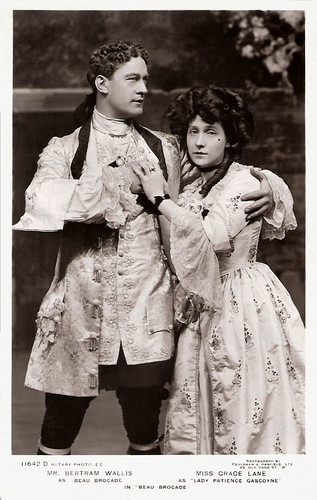
British postcard by Rotary Photo, E.C., no. 11642-D. Photo: Foulsham & Banfield, Ltd., London. Publicity still for the play 'Beau Brocade' (1911) with Bertram Wallis as Beau Brocade and Grace Lane as Lady Patience Gascoyne.
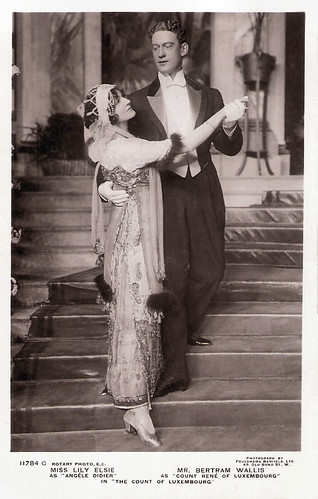
British postcard by Rotary Photo, E.C., no. 11784 C. Photo: Foulsham & Banfield, Ltd. Bertram Wallis and Lily Elsie in 'The Count of Luxembourg'.
Sources: David Slattery-Christy (Anything But Merry!: The Life and Times of Lily Elsie), Wikipedia; Richard Traubner (Operetta: A Theatrical History) and .

British postcard by Rotary Photo, E.C., no. 11642-0. Photo: Foulsham & Barnfield, Ltd., London.

British postcard by Rotary Photo, E.C., no. 2387 C. Photo: Foulsham & Banfield, Ltd., London. Collection: Manuel Palomino Arjona @ Flickr.
Rare Talent
Bertram Wallis was a huge man who stood more than 2 metres tall. He was born in 1874 in London. His parents were Frederick Augustus Wallis and Sarah Mary (née Williams).
Bertram won the Westmorland Scholarship to study voice at the Royal Academy of Music. There he won the Parepa-Rosa gold medal and the Evill Prize.
His first professional engagements were in George Alexander 's production of William Shakespeare’s 'As You Like It' (1896) and in Shakespeare’s 'Much Ado About Nothing' (1898).
In the early years of the 20th century, Wallis had his first successes on the musical stage, such as in 'A Country Girl'. He had the rare talent of being able to sing beautifully and also act superbly.
He then travelled to New York to play in several Broadway productions, including 'A Madcap Princess' (1904), 'Princess Beggar' (1907), and 'Miss Hook of Holland' (1907-1908).

British postcard by Rotary Photo, E.C., no. 2387 E. Photo: Foulsham & Banfield. Publicity still for the play 'The King of Caledonia' (1908).

British postcard by Rotary Photo, E.C., no. 2387 B. Photo: Foulsham & Banfield. Publicity still for the play 'The King of Caledonia' (1908). Collection: Manuel Palomino Arjona @ Flickr.
Glamorous Matinee Idol
Bertram Wallis returned to London and established his career in the operetta 'King of Cadonia'(1908) at the Prince of Wales theatre in the West End. From this point on, he reigned as one of the Edwardian age’s most glamorous matinee idols and one of its biggest male postcard-sellers.
He starred in a number of successful London musicals, often with Isabel Jay or José Collins, including 'Dear Little Denmark'(1909), 'The Balkan Princess' (1910), 'The Count of Luxembourg'(1911), and 'The Happy Day'(1916).
A hit was the revue 'Zig Zag!' (1917). Wallis' later musicals included 'A Southern Maid' (1920), 'Madame Pompadour' (1923), 'Blue Eyes' (1928), and 'So This is Love' (1929). In 1911, Wallis temporarily left the musical stage to appear in a non-musical melodrama, Beau Brocade at the Globe Theatre, for which he won good notices.
Between 1917 and 1945 Bertram Wallis also appeared in eight films. He first appeared in two silent films The Cost of a Kiss (Adrian Brunel, 1917) and Victory and Peace (Herbert Brenon, 1918).
After the introduction of sound film, he acted in The Wandering Jew (Maurice Elvey, 1933) starring Conrad Veidt . During the 1930s, he also played in the short film A Dream of Love (James A. FitzPatrick, 1938), Chips (Edward Godal, 1938), and A People Eternal (Maurice Elvey, Henry Lynn, 1939) again starring Conrad Veidt .
His final two films were The Shipbuilders (John Baxter, 1944) with Clive Brook , and Twilight Hour (Paul L. Stein, 1945).
After the Second World War, Bertram Wallis retired. He died in 1952 at home in Kent. He was 78.

British postcard by Rotary Photo, E.C., no. 11642-D. Photo: Foulsham & Banfield, Ltd., London. Publicity still for the play 'Beau Brocade' (1911) with Bertram Wallis as Beau Brocade and Grace Lane as Lady Patience Gascoyne.

British postcard by Rotary Photo, E.C., no. 11784 C. Photo: Foulsham & Banfield, Ltd. Bertram Wallis and Lily Elsie in 'The Count of Luxembourg'.
Sources: David Slattery-Christy (Anything But Merry!: The Life and Times of Lily Elsie), Wikipedia; Richard Traubner (Operetta: A Theatrical History) and .
Published on May 27, 2019 22:00
May 26, 2019
Diane Lane
American actress Diane Lane (1965) started her film career opposite Laurence Olivier at age 13. She appeared in Francis Coppola's cult classics Rumble Fish (1983) and The Outsiders (1983) and the gangster epic The Cotton Club (1984). She had her breakthrough with The Perfect Storm (2000) and Unfaithful (2002) opposite Richard Gere and since then appeared in several blockbusters including Man of Steel (2013).
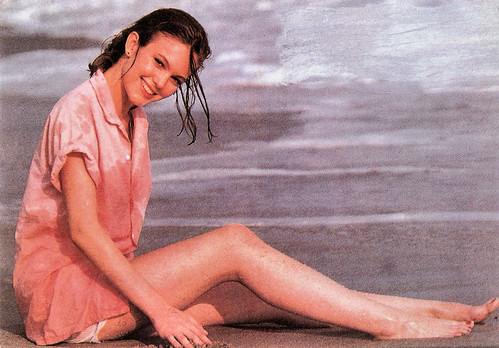
French postcard by Edition Erving, Paris, no. 719.
The new young acting sensation
Diane Lane was born in 1965, in New York. She is the daughter of acting coach Burton Eugene 'Burt' Lane and nightclub singer/centrefold Colleen Farrington. Her parents' families were both from the state of Georgia.
Diane was acting from a very young age and made her stage debut at the age of six. Her work in such acclaimed theatre productions as 'The Cherry Orchard' and 'Medea' led to her being called to Hollywood.
She was 13 when she was cast by director George Roy Hill in his wonderful film A Little Romance (1979), opposite Sir Laurence Olivier . The film only did so-so commercially, but Olivier praised his young co-star, calling her "the new Grace Kelly ".
After her well-received debut, Diane found herself on magazine covers all over the world, including Time, which declared her the "new young acting sensation". However, things quietened down a bit when she found herself in such critical and financial flops as Touched by Love (Gus Trikonis, 1980), Cattle Annie and Little Britches (Lamont Johnson, 1981), Movie Madness (Bob Giraldi, Henry Jaglom, 1982), and, most unmemorably, Six Pack (Daniel Petrie, 1982), starring Kenny Rogers. All failed to set her career on fire.
She also made several TV movies during this period, but it was in 1983 that she finally began to fulfil the promise of stardom that had earlier been predicted for her. Francis (Ford) Coppola took note of Diane's appeal and cast her in two youth-oriented films based on S.E. Hinton novels: Rumble Fish (1983) and The Outsiders (1983), which have become cult classics.
The industry was now taking notice of Diane Lane, and she soon secured lead roles in three big-budget studio epics. She turned down the first, Splash (Ron Howard, 1984) which was a surprise hit for Daryl Hannah. Unfortunately, the other two were critical and box-office bombs: Walter Hill's glossy rock 'n' roll fable Streets of Fire (1984) was not the huge summer success that many had thought it would be, and the troubled Coppola epic The Cotton Club (Francis Coppola, 1984) co-starring Richard Gere was also a high-profile flop.
Unhappy with the direction her career was taking, she 'retired' from the film business at age 19, saying that she had forgotten what she had started acting for. She stayed away from the screen for the next three years. Ironically, the two films that were the main causes of her 'retirement' have since grown in popularity, and Streets of Fire especially seems to have found the kind of audience it couldn't get when it was first released.
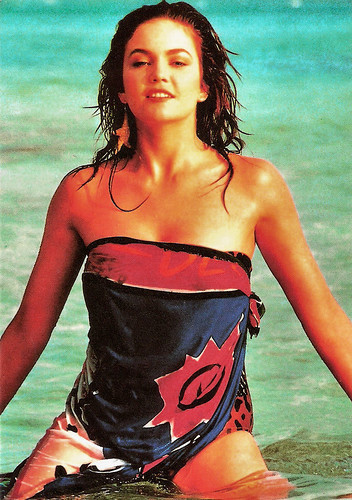
French postcard by Edition Erving, Paris, no. 755.
New, sexy on-screen image
After her interval, Diane Lane started to rebuild her career slowly. First came the obscure, sexy thriller Lady Beware (Karen Arthur, 1987), followed by the critically acclaimed but little seen The Big Town (Ben Bolt, 1987) with Matt Dillon and Tommy Lee Jones. In the former, Lane plays a very mysterious and sexy stripper and her memorable strip sequence is a highlight of the film.
Despite her new, sexy on-screen image, it wasn't until the TV mini-series Lonesome Dove (Simon Wincer, 1989) with Robert Duvall, that Diane made another big impression on a sizable audience. Her performance in the smash hit Western epic as a vulnerable 'whore with a heart' won her an Emmy nomination.
Film producers were interested in her again. Another well-received TV production, Descending Angel (Jeremy Kagan, 1990) with George C. Scott, was followed by smaller roles in major films like Richard Attenborough 's Chaplin (1992) and Mike Binder's Indian Summer (1993), and larger parts in small independent films like Knight Moves (Carl Schenkel, 1992), which co-starred her then-husband, Christophe Lambert .
Lane was now re-established in Hollywood and started to appear in higher-profile co-starring roles in some big-budget, major films like Walter Hill's Wild Bill (1995), the Sylvester Stallone actioner Judge Dredd (Danny Cannon, 1995), the Robin Williams comedy Jack (Francis Coppola, 1996) and Murder at 1600 (Dwight H. Little, 1997) co-starring Wesley Snipes.
However, these films still did not quite make Diane a 'big-name star' and, by 1997, she was back in smaller, personal projects. Her next role as a frustrated 1960s housewife in the independent hit A Walk on the Moon (Tony Goldwyn, 1999) deservedly won her rave notices and gave her career the big lift it needed. The cute but tear-jerking comedy My Dog Skip (Jay Russell, 2000) also proved to be a small-scale success.
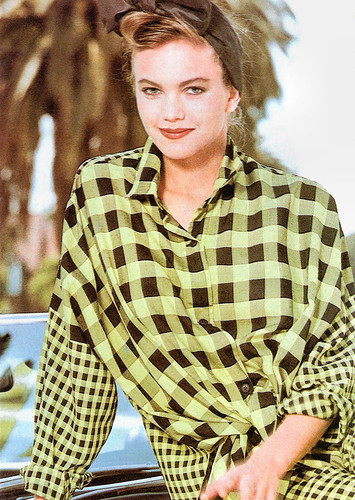
French postcard by Edition Erving, Paris, no. 718.
Finally a household name
Diane Lane finally became a household name with the £330-million worldwide grossing blockbuster hit The Perfect Storm (Wolfgang Petersen, 2000) with George Clooney and Mark Wahlberg.
She was now more in demand than ever. She played Leelee Sobieski's sinister junkie guardian in the slick thriller The Glass House (Daniel Sackheim, 2001), and co-starred with Keanu Reeves in the #1 smash hit Hard Ball (Brian Robbins, 2001).
A highlight was her lead role in the critical and commercial hit Unfaithful (Adrian Lyne, 2002), in which she superbly portrayed Richard Gere's adulterous wife. Her performance won many awards and nominations including Best Actress Oscar and Golden Globe nominations.
Her follow-up films included Must Love Dogs (Gary David Goldberg, 2005), Hollywoodland (Allen Coulter, 2006), Secretariat (Randall Wallace, 2010), and the blockbuster Man of Steel (Zack Snyder, 2013), starring Henry Cavill.
She won further Best Actress Golden Globe nominations for her roles in Under the Tuscan Sun (Audrey Wells, 2003), and Cinema Verite (Shari Springer Berman, Robert Pulcini, 2011).
Recent pictures include Batman v Superman: Dawn of Justice (Zack Snyder, 2016), Justice League (Zack Snyder, 2017), and Tully (Jason Reitman, 2018) with Charlize Theron.
Daryl Moulton at IMDb : "She is very well regarded within the industry, adored by film fans, and has a credibility and quality that is all too rare today. Her immense talent at playing human and real characters, her 'drop dead gorgeous' beauty and down-to-earth grittiness guarantees that she will stay on top, and she guarantee has already shown the kind of resilience that will keep her working for a long, long time."
Diane Lane was married to Christophe Lambert from 1988 to 1994. They have one child, a daughter, Eleanor Lambert. Her second marriage to Josh Brolin in 2004 ended in a divorce in 2013.
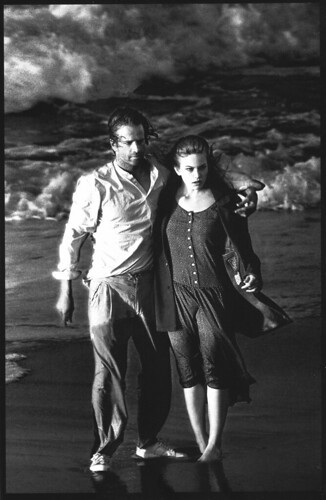
Picture of Italian calendar 'Forto grammi di set'. Photo: Gianni Caramanico. Publicity still for Love Dream (Charles Finch, 1988) with Christophe Lambert .
Sources: (IMDb), Wikipedia and .

French postcard by Edition Erving, Paris, no. 719.
The new young acting sensation
Diane Lane was born in 1965, in New York. She is the daughter of acting coach Burton Eugene 'Burt' Lane and nightclub singer/centrefold Colleen Farrington. Her parents' families were both from the state of Georgia.
Diane was acting from a very young age and made her stage debut at the age of six. Her work in such acclaimed theatre productions as 'The Cherry Orchard' and 'Medea' led to her being called to Hollywood.
She was 13 when she was cast by director George Roy Hill in his wonderful film A Little Romance (1979), opposite Sir Laurence Olivier . The film only did so-so commercially, but Olivier praised his young co-star, calling her "the new Grace Kelly ".
After her well-received debut, Diane found herself on magazine covers all over the world, including Time, which declared her the "new young acting sensation". However, things quietened down a bit when she found herself in such critical and financial flops as Touched by Love (Gus Trikonis, 1980), Cattle Annie and Little Britches (Lamont Johnson, 1981), Movie Madness (Bob Giraldi, Henry Jaglom, 1982), and, most unmemorably, Six Pack (Daniel Petrie, 1982), starring Kenny Rogers. All failed to set her career on fire.
She also made several TV movies during this period, but it was in 1983 that she finally began to fulfil the promise of stardom that had earlier been predicted for her. Francis (Ford) Coppola took note of Diane's appeal and cast her in two youth-oriented films based on S.E. Hinton novels: Rumble Fish (1983) and The Outsiders (1983), which have become cult classics.
The industry was now taking notice of Diane Lane, and she soon secured lead roles in three big-budget studio epics. She turned down the first, Splash (Ron Howard, 1984) which was a surprise hit for Daryl Hannah. Unfortunately, the other two were critical and box-office bombs: Walter Hill's glossy rock 'n' roll fable Streets of Fire (1984) was not the huge summer success that many had thought it would be, and the troubled Coppola epic The Cotton Club (Francis Coppola, 1984) co-starring Richard Gere was also a high-profile flop.
Unhappy with the direction her career was taking, she 'retired' from the film business at age 19, saying that she had forgotten what she had started acting for. She stayed away from the screen for the next three years. Ironically, the two films that were the main causes of her 'retirement' have since grown in popularity, and Streets of Fire especially seems to have found the kind of audience it couldn't get when it was first released.

French postcard by Edition Erving, Paris, no. 755.
New, sexy on-screen image
After her interval, Diane Lane started to rebuild her career slowly. First came the obscure, sexy thriller Lady Beware (Karen Arthur, 1987), followed by the critically acclaimed but little seen The Big Town (Ben Bolt, 1987) with Matt Dillon and Tommy Lee Jones. In the former, Lane plays a very mysterious and sexy stripper and her memorable strip sequence is a highlight of the film.
Despite her new, sexy on-screen image, it wasn't until the TV mini-series Lonesome Dove (Simon Wincer, 1989) with Robert Duvall, that Diane made another big impression on a sizable audience. Her performance in the smash hit Western epic as a vulnerable 'whore with a heart' won her an Emmy nomination.
Film producers were interested in her again. Another well-received TV production, Descending Angel (Jeremy Kagan, 1990) with George C. Scott, was followed by smaller roles in major films like Richard Attenborough 's Chaplin (1992) and Mike Binder's Indian Summer (1993), and larger parts in small independent films like Knight Moves (Carl Schenkel, 1992), which co-starred her then-husband, Christophe Lambert .
Lane was now re-established in Hollywood and started to appear in higher-profile co-starring roles in some big-budget, major films like Walter Hill's Wild Bill (1995), the Sylvester Stallone actioner Judge Dredd (Danny Cannon, 1995), the Robin Williams comedy Jack (Francis Coppola, 1996) and Murder at 1600 (Dwight H. Little, 1997) co-starring Wesley Snipes.
However, these films still did not quite make Diane a 'big-name star' and, by 1997, she was back in smaller, personal projects. Her next role as a frustrated 1960s housewife in the independent hit A Walk on the Moon (Tony Goldwyn, 1999) deservedly won her rave notices and gave her career the big lift it needed. The cute but tear-jerking comedy My Dog Skip (Jay Russell, 2000) also proved to be a small-scale success.

French postcard by Edition Erving, Paris, no. 718.
Finally a household name
Diane Lane finally became a household name with the £330-million worldwide grossing blockbuster hit The Perfect Storm (Wolfgang Petersen, 2000) with George Clooney and Mark Wahlberg.
She was now more in demand than ever. She played Leelee Sobieski's sinister junkie guardian in the slick thriller The Glass House (Daniel Sackheim, 2001), and co-starred with Keanu Reeves in the #1 smash hit Hard Ball (Brian Robbins, 2001).
A highlight was her lead role in the critical and commercial hit Unfaithful (Adrian Lyne, 2002), in which she superbly portrayed Richard Gere's adulterous wife. Her performance won many awards and nominations including Best Actress Oscar and Golden Globe nominations.
Her follow-up films included Must Love Dogs (Gary David Goldberg, 2005), Hollywoodland (Allen Coulter, 2006), Secretariat (Randall Wallace, 2010), and the blockbuster Man of Steel (Zack Snyder, 2013), starring Henry Cavill.
She won further Best Actress Golden Globe nominations for her roles in Under the Tuscan Sun (Audrey Wells, 2003), and Cinema Verite (Shari Springer Berman, Robert Pulcini, 2011).
Recent pictures include Batman v Superman: Dawn of Justice (Zack Snyder, 2016), Justice League (Zack Snyder, 2017), and Tully (Jason Reitman, 2018) with Charlize Theron.
Daryl Moulton at IMDb : "She is very well regarded within the industry, adored by film fans, and has a credibility and quality that is all too rare today. Her immense talent at playing human and real characters, her 'drop dead gorgeous' beauty and down-to-earth grittiness guarantees that she will stay on top, and she guarantee has already shown the kind of resilience that will keep her working for a long, long time."
Diane Lane was married to Christophe Lambert from 1988 to 1994. They have one child, a daughter, Eleanor Lambert. Her second marriage to Josh Brolin in 2004 ended in a divorce in 2013.

Picture of Italian calendar 'Forto grammi di set'. Photo: Gianni Caramanico. Publicity still for Love Dream (Charles Finch, 1988) with Christophe Lambert .
Sources: (IMDb), Wikipedia and .
Published on May 26, 2019 22:00
May 25, 2019
Photo by Gainsborough
Gainsborough Pictures was a British film studio based on the south bank of the Regent's Canal, in north London. Gainsborough Studios was active between 1924 and 1951. The company was initially based at Islington Studios. Other films were made at Lime Grove and Pinewood Studios. The studio is best remembered for the Gainsborough melodramas it produced in the 1940s with such stars as Margaret Lockwood, James Mason and Stewart Granger.
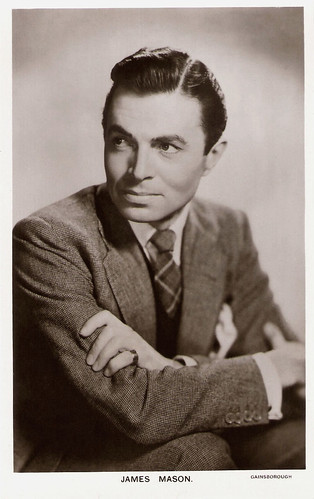
British postcard in the Picturegoer Series, London, no. 151. Photo: Gainsborough.
Gifted English actor James Mason (1909-1984) played in 150 British and American (TV) films and was three times nominated for an Oscar. His distinctive voice enabled him to play a menacing villain as greatly as his good looks assisted him as a matinee idol with a dark side.
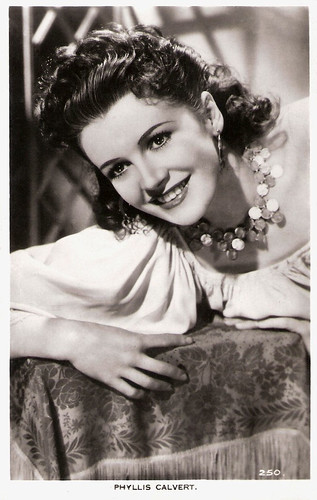
British postcard by Real Photograph, no. 250. Sent by mail in 1948. Photo: publicity still for Madonna of the Seven Moons (Arthur Crabtree, 1945).
English film, stage and television actress Phyllis Calvert (1915-2002) was one of the leading stars of the Gainsborough drawing-room comedies and costume melodramas, which helped to put the British film industry on the map immediately after World War II. At the time she was voted in polls as Britain's second most popular actress, behind Margaret Lockwood . Her 70-year film career had started already in the silent era and ended in 1997.
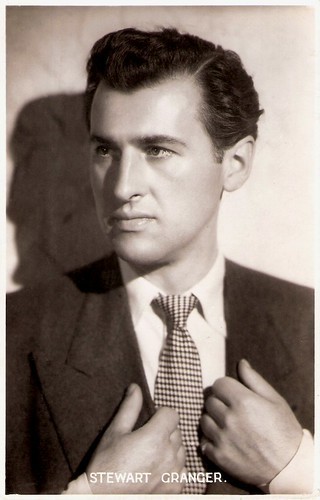
British Postcard, no. F.S. 31. Stewart Granger in Saraband for Dead Lovers (Basil Dearden, 1948).
English actor Stewart Granger (1913–1993) became Britain's top box office star in the 1940s which attracted Hollywood's attention. Tall, dark, dignified and handsome, Granger made over 60 films but is mainly associated with heroic and romantic leading roles. He was quoted: “I've never done a film I'm proud of”.
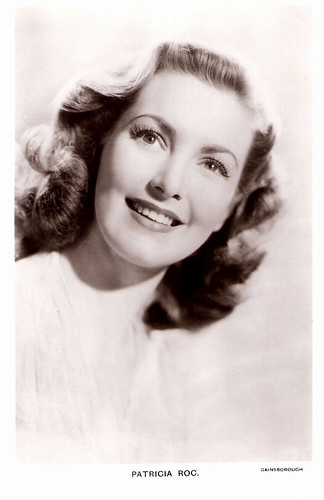
British postcard in the Picturegoer Series, London, nr. W 145. Photo: Gainsborough.
Fresh-faced Patricia Roc (1915-2003) was between 1943 and 1953 one of Britain's top 10 box office stars. The elegant, well spoken actress seemed the epitome of the English rose. She had international success in such Gainsborough costume dramas as Madonna of the Seven Moons (1945) and The Wicked Lady (1945), and in When the Bough Breaks (1947), in which she played an unmarried mother.
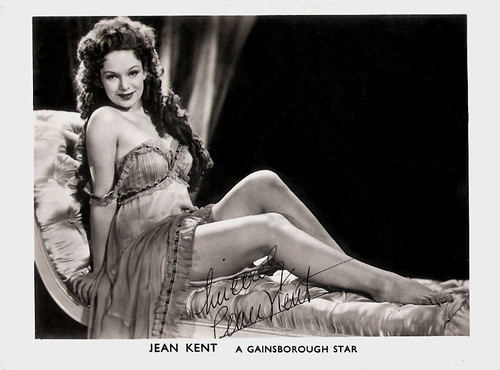
British collectors card. Photo: Gainsborough.
Jean Kent (1921-2013) was a strawberry-blonde British actress who played spiteful hussies or femmes fatales in British films of the 1940s and 1950s.
B films and melodramas
Gainsborough was founded in 1924 by producer Michael Balcon and director Graham Cutts. In 1927, Gainsborough became associated to Gaumont-British, which was set up by the Ostrer brothers. Balcon became director of production for both studios. Gaumont-British, the mother company based at Shepherd's Bush produced the 'quality' pictures, while Gainsborough mainly produced B films and melodramas at its Islington Studios.
Both studios used continental film practices, especially those from Germany. Alfred Hitchcock was encouraged by Balcon, who had links with Ufa, to study there and make multilingual co-production films with Ufa, before the war. Gainsborough also specialised in the production of multilingual films in the late 1920s and early 1930s.
After the rise of Adolph Hitler, both Balcon's companies offered employment to artists who left Nazi-Germany, including Conrad Veidt , Elisabeth Bergner , art director Alfred Junge, cinematographer Mutz Greenbaum and screenwriter/director Berthold Viertel,.
The studio's opening logo was of a lady (Glennis Lorimer) in a Georgian era period costume sitting in an ornate frame, turning and smiling, based on the famous portrait of Sarah Siddons by Thomas Gainsborough. The short piece of music was written by Louis Levy and called 'the Gainsborough Minuet'.
After the departure of Balcon to MGM-British in 1936, the Rank Organisation gained an interest in Gainsborough. Maurice Ostrer became more involved in production, and producer Ted Black was more influential in the running of the studio. Black had an unerring sense of British popular taste, and production was skewed to the home market with such films as Oh, Mr Porter! (Marcel Varnel, 1937) starring Will Hay, and Owd Bob (Robert Stevenson, 1938). Another hit for the studio was The Lady Vanishes (Alfred Hitchcock, 1938) with Michael Redgrave and Margaret Lockwood .
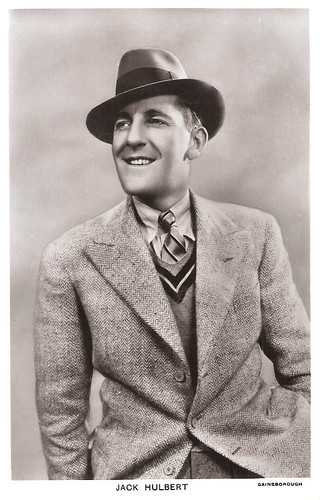
British postcard in the Picturegoer Series, London, no. 782. Photo: Gainsborough.
British actor Jack Hulbert (1892-1978) was a popular comedian of the 1930s with a trademark chiselled chin. In his musicals he often appeared with his wife Cicely Courtneidge .
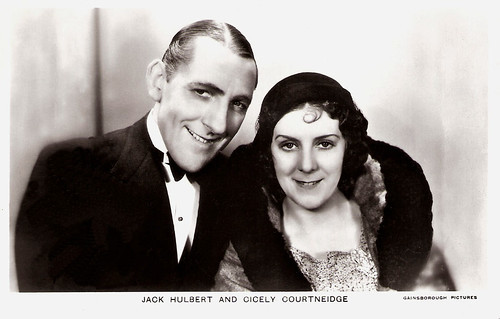
British postcard in the Film Partners Series, no. P 42. Photo: Gainsborough Pictures. Jack Hulbert and Cicely Courtneidge in Jack's the Boy (Walter Forde, 1932).
British actress Cicely Courtneidge (1893-1980) was an elegantly knockabout comedienne. For 62 years, she formed a husband and wife team with comedian Jack Hulbert on stage, radio, TV and in the cinema. During the 1930s she also starred in eleven British films and one disastrous American production.

British postcard in the Picturegoer Series, London, no. 785. Photo: Gainsborough. Dorothy Hyson in Soldiers of the King (Maurice Elvey, 1933)
American actress Dorothy Hyson (1914–1996) led a successful stage and film career in London. Noted for her great beauty and striking looks, the songwriters Rogers and Hart dedicated their song, The Most Beautiful Girl in the World, to her. She was a byword for theatrical West End glamour, but also worked as a cryptographer for the secret service during the war.
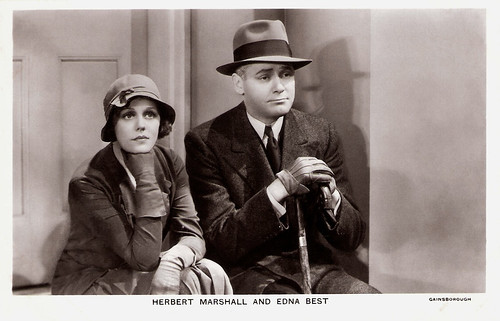
British postcard in the Film Partners series, London, no. P 72. Photo: Gainsborough.
Ladylike British actress Edna Best (1900-1974) entered films in 1921. She is best remembered as the mother in the original version of Alfred Hitchcock's The Man Who Knew Too Much (1934) and as the second wife of film star Herbert Marshall . She worked both on stage and in the cinema, in the United Kingdom and in the United States.
Herbert Marshall (1890-1966), was a popular English cinema and theatre actor. He overcame the loss of a leg in World War I to enjoy a long career in Hollywood, first as a romantic lead opposite stars like Marlene Dietrich and Greta Garbo , later as a fine character actor.
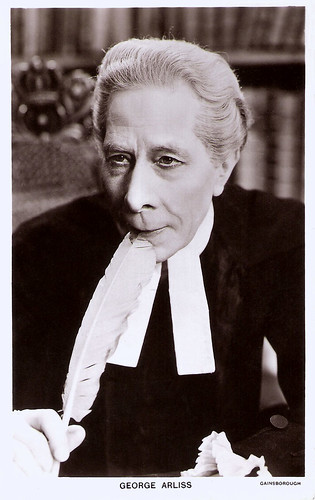
British postcard in the Picturegoer Series, London, no. 473b. Photo: Gainsborough. George Arliss in Doctor Syn (Roy William Neill, 1937).
George Arliss (1868-1946) was the first British actor to win an Academy Award. He was also an author, a playwright, and a Hollywood film maker with an unusual amount of creative control.
Gypsies, wanton women and lustful aristocrats
By 1937, Gaumont-British were in financial crisis, and closed their Lime Grove studios, moving all production to the Islington Poole Street studio. However, the tall factory chimney on the site was considered dangerous in the event of bombing during World War II, and thus Gainsborough Studios were evacuated to Lime Grove for the duration of hostilities.
With the outbreak of war, Gainsborough was poised to dominate the popular market. Rank had a hands-off policy on the company, and the Ostrers gave Ted Black his head in the orchestration of film topics. From 1942, a crucial figure in the Gainsborough production team was R.J. Minney, a successful novelist and former Hollywood scriptwriter. Minney and Black inaugurated a series of visually extravagant and morally ambivalent costume melodramas at Gainsborough which dominated the domestic market from 1942 to 1946.
These costume melodramas were based on recent popular books by female novelists, foregrounding gypsies, wanton women and lustful aristocrats. They were made into films which mined a rich seam in British popular culture: films such as The Man in Grey (Leslie Arliss, 1943) starring James Mason , Fanny by Gaslight (1944), Madonna of the Seven Moons (Arthur Crabtree, 1944) with Phyllis Calvert , The Wicked Lady (Leslie Arliss, 1945) featuring Margaret Lockwood , and Caravan (Arthur Crabtree, 1946), starring Stewart Granger and Jean Kent .
Black and Minney encouraged the careers of a new breed of British stars, including Margaret Lockwood , James Mason , Stewart Granger , Phyllis Calvert , Jean Kent , Anne Crawford, Dennis Price, and Patricia Roc . Critics and male viewers excoriated the Gainsborough costume melodramas, but the female side of the British audience took them to their hearts.
The studio also specialised in comedies and modern-dress melodramas. Popular melodramas such as Love Story (Leslie Arliss, 1944), and They Were Sisters (Arthur Crabtree, 1945) dealt with desire, anger and sartorial envy. The comedies including Time Flies (Walter Forde, 1944) starring Tommy Handley, Bees in Paradise (Val Guest, 1944) with Arthur Askey were less popular at the box office.
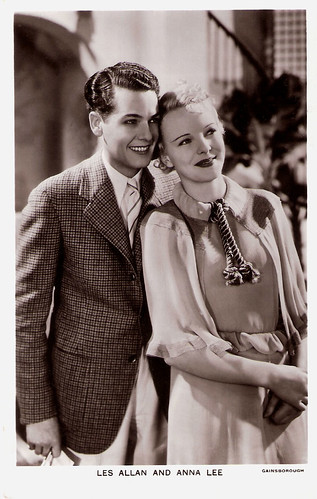
British postcard in the Film Partners Series, London, no. P 182. Photo: Gainsborough. Anna Lee and Les Allen in Heat Wave (Maurice Elvey, 1935).
Blue-eyed blonde Anna Lee (1913-2004) was a British-born American actress. She started her career in British films and earned the title 'Queen of the Quota Quickies'. In 1939, she moved to Hollywood with her husband, director Robert Stevenson. There she often worked with John Ford, and later became a TV star in the soap General Hospital.
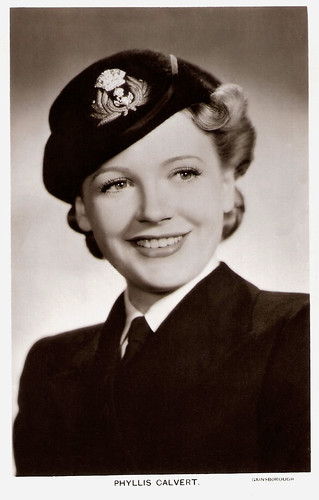
British postcard in the Picturegoer Series, London, no. W 131. Photo: Gainsborough. Phyllis Calvert in The Man in Grey (Leslie Arliss, 1943).
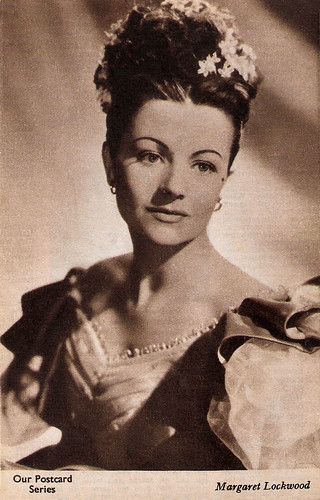
British postcard in the Our Postcard Series, 1948. Photo: Margaret Lockwood in Jassy (Bernard Knowles, 1947).
Beautiful stage and film actress Margaret Lockwood (1916-1990) was the female lead of the early Hitchcock classic The Lady Vanishes (1938). In the 1940s she became Britain's leading box-office star specialising in beautiful but diabolical adventuresses.

British postcard, no. F.S. 30. Mai Zetterling in Quartet (Ralph Smart, a.o., 1948), a Sydney Box production for Gainsborough Pictures.
Lovely Swedish actress and film director Mai Zetterling (1925-1994) graced many European films in the 1940s and 1950s with her slim figure, green eyes, blonde hair and bewitchingly elfin features.

British postcard by Real Photograph, no. F.S. 29. Photo: Gainsborough Pictures. Dennis Price in The Bad Lord Byron (David MacDonald, 1949).
British actor Dennis Price (1915-1973) made nearly 130 films and television plays. He started as a suave leading man, and became a character star of great versatility.
The only female producer in British cinema
Sue Harper in the Encyclopedia of British Film: "After 1946, Rank's henchmen began to intervene more directly in production, and one by one the disillusioned Gainsborough specialists left. The Ostrers resigned, Black went to MGM, Minney left film production and Rank wished to appoint a successor who would continue their popular melodrama trajectory.
He chose Sydney Box, mistakenly thinking that his The Seventh Veil (Compton Bennett, 1945) provided the right pedigree. But Box was essentially interested in verisimilitude of method and appearance. Films such as Here Come the Huggetts (Ken Annakin, 1948), and A Boy, a Girl and a Bike (Ralph Smart, 1949) were predicated on social realism. Box's output was uneven, and he was hampered by inexperience, bad planning and expensive location work. Gainsborough's dominance at the box-office declined drastically, and Rank cut his losses by closing the studio in 1950."
However, Box ushered in some important innovations in film practice. He appointed his sister Betty Box as producer at the Islington arm of Gainsborough, and gave her sufficient autonomy to develop a substantial career. As the only female producer in British cinema at the time, she oversaw such films as the neo-realist Holiday Camp (Ken Annakin, 1947), which introduced the Huggett family and started a successful series, starring Jack Warner, Kathleen Harrison, and Petula Clark , and the mermaid comedy Miranda (Ken Annakin, 1948) featuring Glynis Johns .
Sue Harper: "Sydney Box also furthered the career of his wife Muriel Box while at Gainsborough, promoting her to head of the Scenario Department. Muriel wrote a number of ground-breaking scripts, in which her feminism was much in evidence. Such films as The Brothers (David McDonald, 1947) and Good-Time Girl (David McDonald, 1948) have scripts which nuance female desire and its punishment in an unusually explicit way."
Unhappy with the performance of the studio, Rank closed it down in early 1949. Production was concentrated at Pinewood Studios. Although at first films continued to be made there under the Gainsborough banner, this quickly stopped and no further Gainsborough films were released after 1951.
The original Lime Grove site was taken over by the BBC in 1949 and remained in use until it was closed in 1991. The buildings were demolished in the early 1990s, and have been since replaced with housing presently called Gaumont Terrace and Gainsborough Court. The former Islington Studios, in Poole Street, remained largely derelict after their closure in 1949 apart from occasional art performances. The studios were demolished in 2002 and replaced by three blocks of upmarket apartments in 2004.
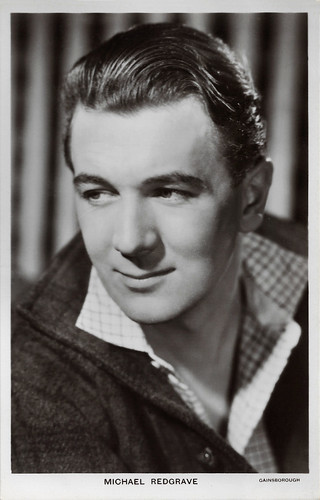
British postcard in the Picturegoer Series, London, no. 1217. Photo: Gainsborough.
Sir Michael Redgrave (1908-1985) was an English stage and film actor, who started starring in a Hitchcock classic and went on to star in many British and some Hollywood productions. He was the father of Vanessa, Lynn and Corin Redgrave.
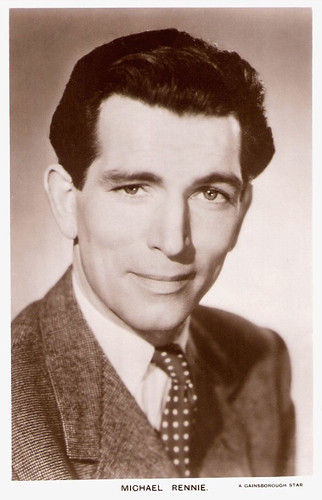
British postcard. Photo: Gainsborough.
English film, television, and stage actor Michael Rennie (1909-1971) was best known for his starring role as the space visitor Klaatu in the Science Fiction classic The Day the Earth Stood Still (1951).
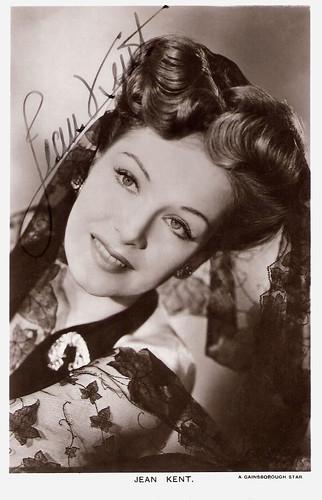
British postcard. Photo: Gainsborough. Jean Kent .
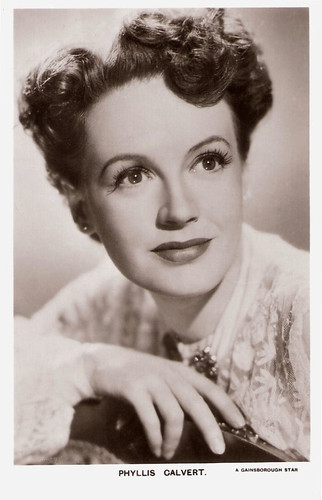
British postcard. Photo: Gainsborough. Phyllis Calvert .
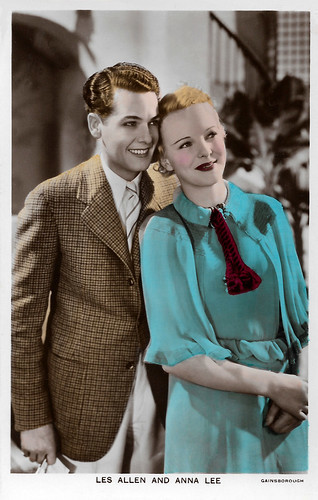
British postcard in the Film Partners Series, London, no. P 182. Photo: Gainsborough. Anna Lee and Les Allen in Heat Wave (Maurice Elvey, 1935).
Sources: Sue Harper (BFI Screenonline), Wikipedia and .

British postcard in the Picturegoer Series, London, no. 151. Photo: Gainsborough.
Gifted English actor James Mason (1909-1984) played in 150 British and American (TV) films and was three times nominated for an Oscar. His distinctive voice enabled him to play a menacing villain as greatly as his good looks assisted him as a matinee idol with a dark side.

British postcard by Real Photograph, no. 250. Sent by mail in 1948. Photo: publicity still for Madonna of the Seven Moons (Arthur Crabtree, 1945).
English film, stage and television actress Phyllis Calvert (1915-2002) was one of the leading stars of the Gainsborough drawing-room comedies and costume melodramas, which helped to put the British film industry on the map immediately after World War II. At the time she was voted in polls as Britain's second most popular actress, behind Margaret Lockwood . Her 70-year film career had started already in the silent era and ended in 1997.

British Postcard, no. F.S. 31. Stewart Granger in Saraband for Dead Lovers (Basil Dearden, 1948).
English actor Stewart Granger (1913–1993) became Britain's top box office star in the 1940s which attracted Hollywood's attention. Tall, dark, dignified and handsome, Granger made over 60 films but is mainly associated with heroic and romantic leading roles. He was quoted: “I've never done a film I'm proud of”.

British postcard in the Picturegoer Series, London, nr. W 145. Photo: Gainsborough.
Fresh-faced Patricia Roc (1915-2003) was between 1943 and 1953 one of Britain's top 10 box office stars. The elegant, well spoken actress seemed the epitome of the English rose. She had international success in such Gainsborough costume dramas as Madonna of the Seven Moons (1945) and The Wicked Lady (1945), and in When the Bough Breaks (1947), in which she played an unmarried mother.

British collectors card. Photo: Gainsborough.
Jean Kent (1921-2013) was a strawberry-blonde British actress who played spiteful hussies or femmes fatales in British films of the 1940s and 1950s.
B films and melodramas
Gainsborough was founded in 1924 by producer Michael Balcon and director Graham Cutts. In 1927, Gainsborough became associated to Gaumont-British, which was set up by the Ostrer brothers. Balcon became director of production for both studios. Gaumont-British, the mother company based at Shepherd's Bush produced the 'quality' pictures, while Gainsborough mainly produced B films and melodramas at its Islington Studios.
Both studios used continental film practices, especially those from Germany. Alfred Hitchcock was encouraged by Balcon, who had links with Ufa, to study there and make multilingual co-production films with Ufa, before the war. Gainsborough also specialised in the production of multilingual films in the late 1920s and early 1930s.
After the rise of Adolph Hitler, both Balcon's companies offered employment to artists who left Nazi-Germany, including Conrad Veidt , Elisabeth Bergner , art director Alfred Junge, cinematographer Mutz Greenbaum and screenwriter/director Berthold Viertel,.
The studio's opening logo was of a lady (Glennis Lorimer) in a Georgian era period costume sitting in an ornate frame, turning and smiling, based on the famous portrait of Sarah Siddons by Thomas Gainsborough. The short piece of music was written by Louis Levy and called 'the Gainsborough Minuet'.
After the departure of Balcon to MGM-British in 1936, the Rank Organisation gained an interest in Gainsborough. Maurice Ostrer became more involved in production, and producer Ted Black was more influential in the running of the studio. Black had an unerring sense of British popular taste, and production was skewed to the home market with such films as Oh, Mr Porter! (Marcel Varnel, 1937) starring Will Hay, and Owd Bob (Robert Stevenson, 1938). Another hit for the studio was The Lady Vanishes (Alfred Hitchcock, 1938) with Michael Redgrave and Margaret Lockwood .

British postcard in the Picturegoer Series, London, no. 782. Photo: Gainsborough.
British actor Jack Hulbert (1892-1978) was a popular comedian of the 1930s with a trademark chiselled chin. In his musicals he often appeared with his wife Cicely Courtneidge .

British postcard in the Film Partners Series, no. P 42. Photo: Gainsborough Pictures. Jack Hulbert and Cicely Courtneidge in Jack's the Boy (Walter Forde, 1932).
British actress Cicely Courtneidge (1893-1980) was an elegantly knockabout comedienne. For 62 years, she formed a husband and wife team with comedian Jack Hulbert on stage, radio, TV and in the cinema. During the 1930s she also starred in eleven British films and one disastrous American production.

British postcard in the Picturegoer Series, London, no. 785. Photo: Gainsborough. Dorothy Hyson in Soldiers of the King (Maurice Elvey, 1933)
American actress Dorothy Hyson (1914–1996) led a successful stage and film career in London. Noted for her great beauty and striking looks, the songwriters Rogers and Hart dedicated their song, The Most Beautiful Girl in the World, to her. She was a byword for theatrical West End glamour, but also worked as a cryptographer for the secret service during the war.

British postcard in the Film Partners series, London, no. P 72. Photo: Gainsborough.
Ladylike British actress Edna Best (1900-1974) entered films in 1921. She is best remembered as the mother in the original version of Alfred Hitchcock's The Man Who Knew Too Much (1934) and as the second wife of film star Herbert Marshall . She worked both on stage and in the cinema, in the United Kingdom and in the United States.
Herbert Marshall (1890-1966), was a popular English cinema and theatre actor. He overcame the loss of a leg in World War I to enjoy a long career in Hollywood, first as a romantic lead opposite stars like Marlene Dietrich and Greta Garbo , later as a fine character actor.

British postcard in the Picturegoer Series, London, no. 473b. Photo: Gainsborough. George Arliss in Doctor Syn (Roy William Neill, 1937).
George Arliss (1868-1946) was the first British actor to win an Academy Award. He was also an author, a playwright, and a Hollywood film maker with an unusual amount of creative control.
Gypsies, wanton women and lustful aristocrats
By 1937, Gaumont-British were in financial crisis, and closed their Lime Grove studios, moving all production to the Islington Poole Street studio. However, the tall factory chimney on the site was considered dangerous in the event of bombing during World War II, and thus Gainsborough Studios were evacuated to Lime Grove for the duration of hostilities.
With the outbreak of war, Gainsborough was poised to dominate the popular market. Rank had a hands-off policy on the company, and the Ostrers gave Ted Black his head in the orchestration of film topics. From 1942, a crucial figure in the Gainsborough production team was R.J. Minney, a successful novelist and former Hollywood scriptwriter. Minney and Black inaugurated a series of visually extravagant and morally ambivalent costume melodramas at Gainsborough which dominated the domestic market from 1942 to 1946.
These costume melodramas were based on recent popular books by female novelists, foregrounding gypsies, wanton women and lustful aristocrats. They were made into films which mined a rich seam in British popular culture: films such as The Man in Grey (Leslie Arliss, 1943) starring James Mason , Fanny by Gaslight (1944), Madonna of the Seven Moons (Arthur Crabtree, 1944) with Phyllis Calvert , The Wicked Lady (Leslie Arliss, 1945) featuring Margaret Lockwood , and Caravan (Arthur Crabtree, 1946), starring Stewart Granger and Jean Kent .
Black and Minney encouraged the careers of a new breed of British stars, including Margaret Lockwood , James Mason , Stewart Granger , Phyllis Calvert , Jean Kent , Anne Crawford, Dennis Price, and Patricia Roc . Critics and male viewers excoriated the Gainsborough costume melodramas, but the female side of the British audience took them to their hearts.
The studio also specialised in comedies and modern-dress melodramas. Popular melodramas such as Love Story (Leslie Arliss, 1944), and They Were Sisters (Arthur Crabtree, 1945) dealt with desire, anger and sartorial envy. The comedies including Time Flies (Walter Forde, 1944) starring Tommy Handley, Bees in Paradise (Val Guest, 1944) with Arthur Askey were less popular at the box office.

British postcard in the Film Partners Series, London, no. P 182. Photo: Gainsborough. Anna Lee and Les Allen in Heat Wave (Maurice Elvey, 1935).
Blue-eyed blonde Anna Lee (1913-2004) was a British-born American actress. She started her career in British films and earned the title 'Queen of the Quota Quickies'. In 1939, she moved to Hollywood with her husband, director Robert Stevenson. There she often worked with John Ford, and later became a TV star in the soap General Hospital.

British postcard in the Picturegoer Series, London, no. W 131. Photo: Gainsborough. Phyllis Calvert in The Man in Grey (Leslie Arliss, 1943).

British postcard in the Our Postcard Series, 1948. Photo: Margaret Lockwood in Jassy (Bernard Knowles, 1947).
Beautiful stage and film actress Margaret Lockwood (1916-1990) was the female lead of the early Hitchcock classic The Lady Vanishes (1938). In the 1940s she became Britain's leading box-office star specialising in beautiful but diabolical adventuresses.

British postcard, no. F.S. 30. Mai Zetterling in Quartet (Ralph Smart, a.o., 1948), a Sydney Box production for Gainsborough Pictures.
Lovely Swedish actress and film director Mai Zetterling (1925-1994) graced many European films in the 1940s and 1950s with her slim figure, green eyes, blonde hair and bewitchingly elfin features.

British postcard by Real Photograph, no. F.S. 29. Photo: Gainsborough Pictures. Dennis Price in The Bad Lord Byron (David MacDonald, 1949).
British actor Dennis Price (1915-1973) made nearly 130 films and television plays. He started as a suave leading man, and became a character star of great versatility.
The only female producer in British cinema
Sue Harper in the Encyclopedia of British Film: "After 1946, Rank's henchmen began to intervene more directly in production, and one by one the disillusioned Gainsborough specialists left. The Ostrers resigned, Black went to MGM, Minney left film production and Rank wished to appoint a successor who would continue their popular melodrama trajectory.
He chose Sydney Box, mistakenly thinking that his The Seventh Veil (Compton Bennett, 1945) provided the right pedigree. But Box was essentially interested in verisimilitude of method and appearance. Films such as Here Come the Huggetts (Ken Annakin, 1948), and A Boy, a Girl and a Bike (Ralph Smart, 1949) were predicated on social realism. Box's output was uneven, and he was hampered by inexperience, bad planning and expensive location work. Gainsborough's dominance at the box-office declined drastically, and Rank cut his losses by closing the studio in 1950."
However, Box ushered in some important innovations in film practice. He appointed his sister Betty Box as producer at the Islington arm of Gainsborough, and gave her sufficient autonomy to develop a substantial career. As the only female producer in British cinema at the time, she oversaw such films as the neo-realist Holiday Camp (Ken Annakin, 1947), which introduced the Huggett family and started a successful series, starring Jack Warner, Kathleen Harrison, and Petula Clark , and the mermaid comedy Miranda (Ken Annakin, 1948) featuring Glynis Johns .
Sue Harper: "Sydney Box also furthered the career of his wife Muriel Box while at Gainsborough, promoting her to head of the Scenario Department. Muriel wrote a number of ground-breaking scripts, in which her feminism was much in evidence. Such films as The Brothers (David McDonald, 1947) and Good-Time Girl (David McDonald, 1948) have scripts which nuance female desire and its punishment in an unusually explicit way."
Unhappy with the performance of the studio, Rank closed it down in early 1949. Production was concentrated at Pinewood Studios. Although at first films continued to be made there under the Gainsborough banner, this quickly stopped and no further Gainsborough films were released after 1951.
The original Lime Grove site was taken over by the BBC in 1949 and remained in use until it was closed in 1991. The buildings were demolished in the early 1990s, and have been since replaced with housing presently called Gaumont Terrace and Gainsborough Court. The former Islington Studios, in Poole Street, remained largely derelict after their closure in 1949 apart from occasional art performances. The studios were demolished in 2002 and replaced by three blocks of upmarket apartments in 2004.

British postcard in the Picturegoer Series, London, no. 1217. Photo: Gainsborough.
Sir Michael Redgrave (1908-1985) was an English stage and film actor, who started starring in a Hitchcock classic and went on to star in many British and some Hollywood productions. He was the father of Vanessa, Lynn and Corin Redgrave.

British postcard. Photo: Gainsborough.
English film, television, and stage actor Michael Rennie (1909-1971) was best known for his starring role as the space visitor Klaatu in the Science Fiction classic The Day the Earth Stood Still (1951).

British postcard. Photo: Gainsborough. Jean Kent .

British postcard. Photo: Gainsborough. Phyllis Calvert .

British postcard in the Film Partners Series, London, no. P 182. Photo: Gainsborough. Anna Lee and Les Allen in Heat Wave (Maurice Elvey, 1935).
Sources: Sue Harper (BFI Screenonline), Wikipedia and .
Published on May 25, 2019 22:00
May 24, 2019
Women Film Pioneers, Part 2: Europe
Today starts the 10th Women and the Silent Screen Conference, hosted by Eye Filmmuseum in Amsterdam. On 8 March, International Women's Day, EFSP had a post with 20 American women who both worked in front of and behind the camera during the silent film era, and whose profile can be found at Women Pioneers Film Project. Part 2 of our post focusses on 20 European women film pioneers. WFPP does not have entries on all the women in this post. Some ladies are still on their wish-list, and of one, Elena Sangro, we think she deserves to be on the list. EFSP's co-editor Ivo Blom selected 20 female film pioneers from as many nationalities as we could find postcards of.
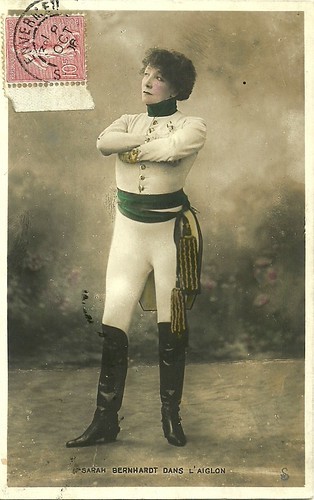
Sarah Bernhardt. French postcard. Sarah Bernhardt in Edmond Rostand's play L'Aiglon. The title role for Rostand's play was created by Bernhardt herself in the play's premiere on 15 March 1900 at the Théàtre Sarah Bernhardt in Paris.
Victoria Duckett at Women Pioneer Film Project: "She was among the first celebrities to engage with the motion picture, playing Hamlet in a one-minute film that formed part of Paul Decauville’s program for the Phono-Cinéma-Théâtre at the Paris Exposition of 1900. The first feature film that she released – Camille (1911) – was promoted the following year by the French American Film Company in Moving Picture World as “Making New Records for Selling States Rights”. A subsequent advertisement in the same trade press claimed that the film was “The Fastest Seller Ever Offered State Right Buyers”. As many film historians know, Bernhardt’s Queen Elizabeth (1912) was the Famous Players Company’s first release in the U.S. It similarly enjoyed success, helping to open the market for legitimate motion picture exhibition in the U.S. Queen Elizabeth thereby provided audiences with their first experience of the longer-playing narrative feature film."
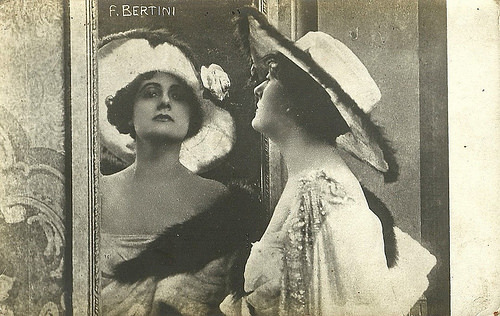
Francesca Bertini . American postcard, monogram K Ltd. Francesca Bertini in Odette (Giuseppe De Liguoro, 1916).
Monica Dall’Asta at Women Pioneer Film Project : "Bertini’s different autobiographical interventions are consistent in reclaiming a creative as well as managerial role in the production of all her major star vehicles. Especially in the long interview recorded by Mingozzi, she credits herself not just for obtaining the rights to adapt 'Assunta Spina' from Di Giacomo, but, more importantly, she argues for directorial recognition for that film. This claim was later confirmed in a 1981 interview with her co-star, and the official director of the film, Gustavo Serena ."
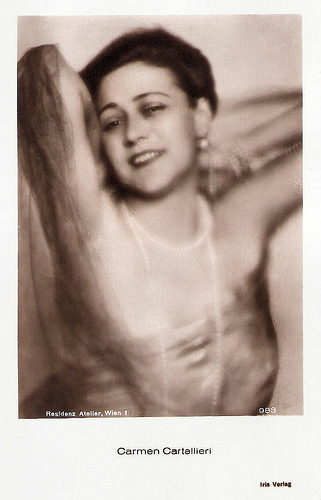
Carmen Cartellieri . Austrian postcard by Iris Verlag, no. 989. Photo: Residenz Atelier, Wien.
Robert von Dassanowsky at Women Pioneer Film Project: "Carmen Cartellieri was born Franziska Ottilia Cartellieri in Prossnitz, Austria-Hungary, which is today Prostejov, Czech Republic, but spent her childhood in Innsbruck, Austria. In 1907, at age sixteen, she married the aristocratic artist-turned-director, Emanuel Ziffer Edler von Teschenbruck. Her husband and Cornelius Hintner, a cameraman from South Tyrol who had worked for Pathé in Paris and then as a director in Hungary, helped make her one of the most fashionable stars in German-language film of the 1920s. Using the stage name of Carmen Teschen, she appeared in several Hungarian silent films between 1918 and 1919 and made her Austrian film debut in Hintner’s Die Liebe vom Zigeunerstamme/The Gypsy Girl (1919), which she reportedly cowrote. Political changes in postwar Hungary made her relocate to Vienna where she returned to her exotic surname, suggesting to the press that she was born in Italy, and founded the Cartellieri-Film company in 1920 with her husband and Hintner."

Aud Egede Nissen . German postcard by Ross Verlag, no. 476/1, 1919-1924. Photo: A. Eberth, Berlin.
Gunnar Iversen at Women Pioneer Film Project: "During the 1910s and 1920s, Aud Egede-Nissen and her sisters Gerd and Ada made a name for themselves in the Nordic and German film industries as actors, producers, and directors. Like many female pioneers in the film industry, their work has been neglected. The contribution of the Egede-Nissen sisters, especially Aud, to silent film in the 1910s is remarkable given the odds they had to overcome as female producers in a male-dominated industry and the lack of tradition and experience in their home country, Norway."
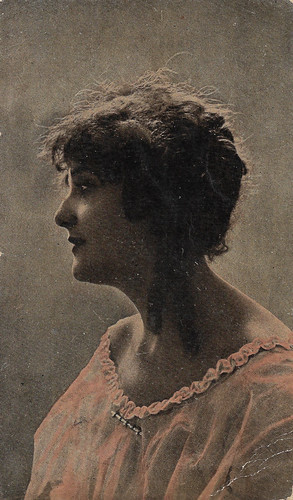
Fabienne Fabrèges. Spanish postcard by Chocolate Salas-Sabadell.
Elena Nepoti at Women Pioneer Film Project: "Her film career, between 1910 and the mid-1920s, can be divided into three periods. Between 1910 and 1916, the actress worked in France for the Société des Établissements Gaumont. During World War I, she relocated to Italy, where she was immediately recognized as a leading actress by the Italian film industry, and, between 1916 and 1923, acted in two dozen films. In many of these films she is credited as the screenwriter, and for one of them, also as the director. Finally in the twenties she left the stage and screen in Italy and most likely moved to England, where it seems she carried out some further stage work, and then her career seems to have come to an end."
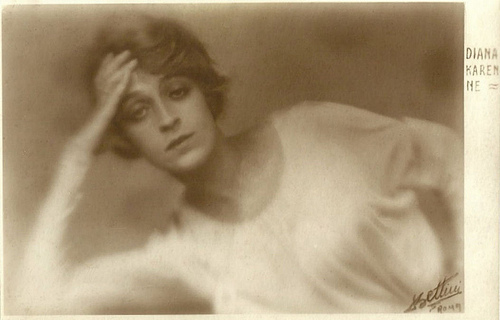
Diana Karenne . Italian postcard by Ed. Soc. Anon. It. Bettini, Roma.
Cristina Jandelli, Linda Del Gamba at Women Film Pioneer Project: " Diana Karenne was one of the most interesting personalities in the Italian and European film scenes of the early 1900s. Star, actress, intellectual, artist, director, screenwriter, and producer, she is representative of an effectual coexistence between two different ways of considering a woman’s role in both the film industry and in a society that was undergoing deep changes as to gender boundaries. Through her artistic career, she supported demands concerning female identity, widely felt between 1800 and 1900: in this very period, Europe was facing a process of modernization and large transformations at every social level. Karenne never took sides towards women’s emancipation movements, yet she opposed conservative morals and social conventions of that time through her personal, aesthetic, and professional choices, and helped to update the idea of cinema thanks to her bold artistic proposals and acting style."
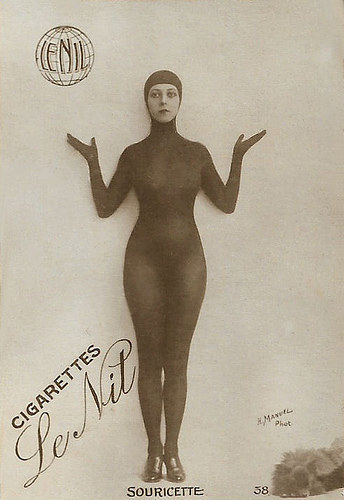
Musidora . French cigarette card by Cigarettes Le Nil, no. 38. Photo: H. Manuel.
Annette Förster at Women Film Pioneer Project: "If we merely looked at contemporary advertisements and reviews, it would appear that Musidora had directed only two films in the silent era: Vicenta (1919), and La terre des taureaux/The Land of the Bulls (1924). These credits can be further substantiated by personal statements about the making of these films published by Musidora herself in contemporary periodicals. There, she additionally claimed credit for writing both scripts as well as for editing La terre des taureaux. However, on the two other films that were produced under the banner of her company, Société des Films Musidora, she credited as director her codirector Jacques Lasseyne. Even the richly illustrated publicity booklets of Pour Don Carlos/For Don Carlos (1921) and Soleil et ombre/Sun and Shadow (1922) listed Musidora only in the cast, and her article in the magazine Ève bore the telling title 'Comment j’ai tourné Don Carlos' or 'How I Acted in Don Carlos'. After the 1940s, however, Musidora began to claim the codirector and adaptation credits of these productions for herself, and these credits have now been accepted as definitive. Additionally, she added the credit for codirection, with Roger Lion, for La flamme cachée/The hidden flame (1918), which she mentioned in a 1950 article on her professional collaboration with her artistic mentor and longtime friend, Colette ."
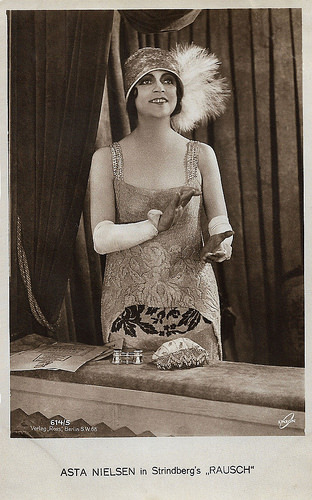
Asta Nielsen . German postcard by Ross Verlag, no. 614/5. Photo: Union. Publicity still for Rausch/Intoxication (Ernst Lubitsch, 1919).
Julie Allen at Women Film Pioneer Project: "Frequently lauded as 'die Duse des Kinos' [the Duse of the cinema], as Poul Elsner noted in Weltrundschau in 1911, the Danish actress Asta Nielsen was the first major star of German silent film. She acted in more than seventy films, all but four of them made with German production companies, during the twenty-two years of her film career. The phenomenal success of her debut film, Afgrunden/The Abyss (1910) enabled her to become the first global film star under the new monopoly distribution system. From 1910 to 1914, she collaborated closely with director Urban Gad, who was also her first husband, under the auspices of Deutsche Bioscop and Projektions-AG “Union” (PAGU), and later established two film companies of her own. Although she struggled to come to terms with the director-centric turn of the film industry in Germany in the 1920s that restricted the artistic autonomy she had enjoyed in the 1910s, she made several of her most artistically impressive films, including several Weimar street films, during this period. In 1932, she acted in her only sound film, Unmögliche Liebe/Impossible Love, which was also her final film, aside from two documentaries about her made decades later."
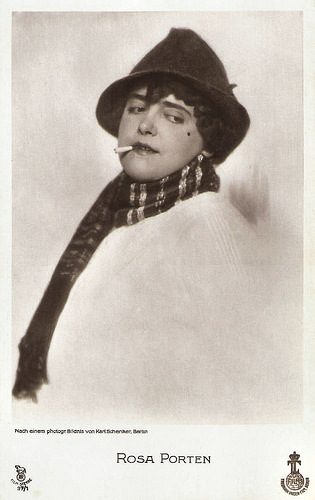
Rosa Porten . German postcard in the Film Sterne series by Rotophot, no. 97/1. Photo: Karl Schenker, Berlin / Treumann- Larsson Film, Berlin.
Annette Förster at Women Film Pioneer Project: " Rosa Porten ’s work as a screenwriter, an actress, and a film director has been practically neglected in film history, but what she accomplished in the German silent cinema is truly noteworthy. In a two-decade career, from 1906 until 1928, she created a cinematic oeuvre that was substantial, original, versatile, and entertaining. The exact number of films to which Rosa Porten contributed is uncertain, but historical substantiation points to around forty titles. Between 1916 and 1919 alone, she wrote and co-directed at least twenty-four catching comedies and gripping social dramas and in most of them she played the protagonist. Even more notable in retrospect is that Porten’s stories often privileged the perspective of a female character who, with non-conformist pragmatism or jokey recalcitrance, seizes her chance to defy bourgeois conventions and role patterns."
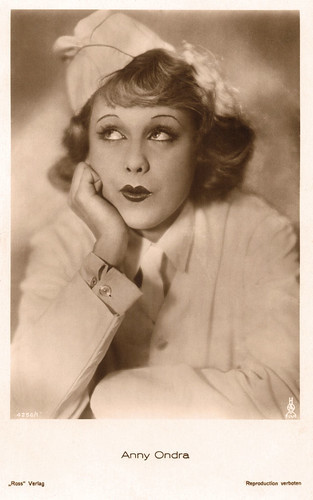
Anny Ondrakova/Ondra . German postcard by Ross Verlag, no. 4250/1, 1929-1930.
Anny Ondra (1903-1987) was born as Anna Sophie Ondráková in Tarnów, Austria-Hungary, now Poland.. During the 1920s and 1930s she was a popular actress in Czech, Austrian and German comedies, and she was Alfred Hitchcock’s first ‘Blonde’. She was discovered at the age of 16 bij actor-director Karel (or Carl) Lamac. They starred together in the film Palimpsest (Joe Jencik, 1919). Lamac would also become her first husband. From 1919 on Anny Ondra often worked together with Lamac as her director and/or her co-star dor their own production company. With their film Gilly po prve v Praze/Gilly zum ersten Mal in Prag/Gilly for the First Time in Prague (Carl Lamac, 1920) she became a big comedy star in the silent Czechoslovakian and Austrian cinema.
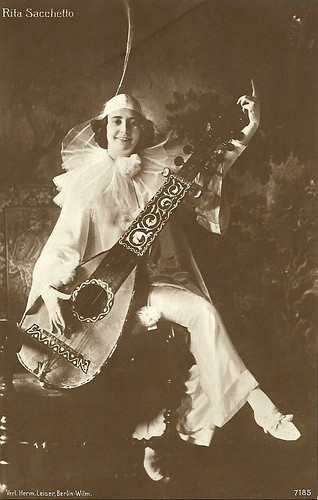
Rita Sacchetto . German Postcard by Verlag Hermann Leiser, Berlin, no. 7185. Collection: Didier Hanson.
German actress and dancer Rita Sacchetto (1879-1959) was in the 1910s a star of the Danish Nordisk Film Company. Nordisk had hired Sacchetto to star in films for the astonishing salary of 7,000 kroner per picture, but she made many quite successful films including Fra Fryste til Knejpevaert/The Gambler's Wife (Holger-Madsen, 1913) and Den Skønne Evelyn/Evelyn the Beautiful (A.W. Sandberg, 1916) with a script by Carl Theodor Dreyer. According to Karl Toepfer in his study 'Empire of Ecstasy: Nudity and Movement in German Body Culture, 1910-1935' "Sacchetto exuded a dusky, melancholy beauty that seemed even more refined and aristocratic, a 'breeze of perfume,' when displayed in opulent historical costumes. Although she excluded modern paintings of women from her graceful productions, she was probably the first to use silent film as a model for composing dances."
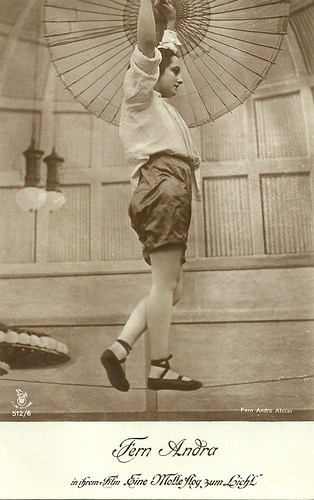
Fern Andra . German postcard by Rotophot in the Film Sterne series, no. 512/6. Photo: Fern Andra Atelier. Fern Andra in Eine Motte flog zum Licht (Fern Andra, 1915).
'Modern' American Fern Andra (1893-1974) became one of the most popular film stars of the German cinema in the 1910s and early 1920s. In her films she mastered tightroping, riding a horse without a saddle, driving cars and motorcycles, bobsleighing, and even boxing. She started her own company, even directing her own films. Right during the First World War, Fern made one film after another, always about women who are victims of cruel events but who are also determined to settle matters. These films included Eine Motte floh zum Licht/A Moth Flew To The Light (Fern Andra, 1915), and Drohende Wolken am Firmament/Threatening Clouds in the Sky (Fern Andra, 1918). Moonlight romance, theatres burning down, and luxurious parties in aristocratic milieux. Unfortunately most of these films were never exported because of the war, and most are lost now.
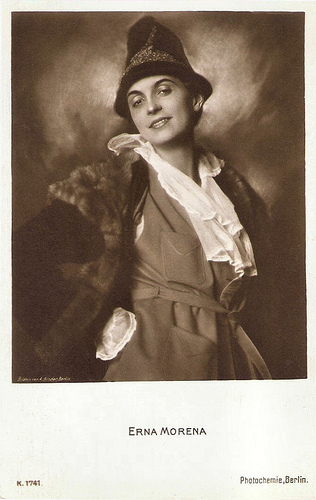
Erna Morena . German postcard by Photochemie, no. K . 1741. Photo: Alex Binder, Berlin.
Although her name is now largely forgotten, Erna Morena (1885-1962) appeared in about 120 films during five decades. She had an enormous career in the German silent cinema of the 1910s and 1920s as both an actress, producer and screenwriter, and until the mid-1930s she was regularly performing in German sound films. In 1918 she founded in Berlin, Erna Morena Film GmbH, supported by some friends as partners. She produced films like Colomba (1918) with Werner Krauss , and Die 999. Nacht/The 999th Night (1919/1920) with Hans Albers . Because of the economic crisis after the German November revolution of 1918-1919, she had to stop producing after two years.
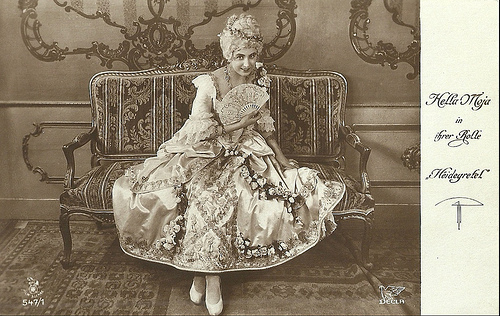
Hella Moja . German postcard in the Film-Sterne series by Rotophot, no. 547/1. Hella Moja in the German silent film Heide-Gretel (Otto Rippert, 1918), produced by the Decla-Filmgellschaft (Eric Pommer).
During the First World War and the following years Hella Moja (1890-1951) was one of the most popular stars of the German silent cinema. There was even a Hella Moja serial and in 1918 she founded her own film company. The Hella Moja Filmgesellschaft would produce 16 films. Her first production was Wundersam ist das Märchen der Liebe/Wondrous is the Fairy Tale of Love (Leo Connard, 1918) with Ernst Hofmann , for which the critics especially praised her acting. Another successful production was Die Augen von Jade/The Eyes of Jade (Iwa Raffay, 1918). In Figaros Hochzeit/The Marriage of Figaro (Max Mack, 1920) based on the play by Pierre Augustin Caron de Beaumarchais, she was again impressive as Cherubino - Figaros page opposite Alexander Moissi as Figaro.
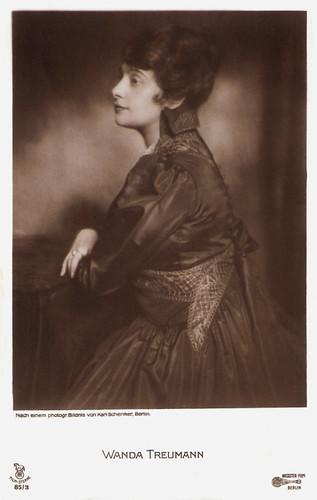
Wanda Traumann . German postcard in the Film Sterne series by Rotophot, no. 85/3. Photo: Karl Schenker / Messter Film, Berlin.
Wanda Traumann (1889–1926) belonged to the most popular stars of the German cinema before the first World War. In 1912, together with actor-director Viggo Larsen and her husband, Karl Treumann, she founded her own production company Treumann-Larsen Film GmbH in Berlin. Officially, Wanda Treumann ’s husband was indicated as owner of the firm. As she said herself in Lichtbild-Theater, no. 41, 1912: "Then we – my master and partner in film, Mr. Oberregisseur Viggo Larsen and me – became fully independent. And so we are now: for the production of our new 'Treumann-Larsen-series', we develop the negatives ourselves which we shoot in our own film studio with our own cast and crew."
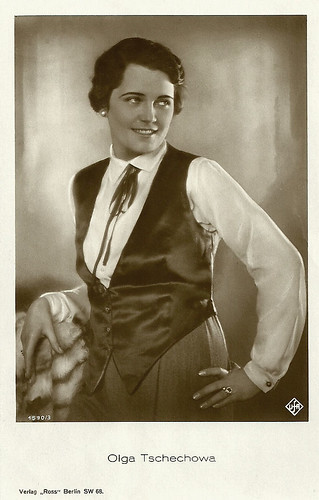
Olga Tschechowa . German postcard by Ross Verlag, no. 1590/3, 1927-1928. Photo: Ufa.
Dignified German-Russian actress Olga Tschechowa (1897-1980) was one of the most popular stars of the silent film era. She played in more than 40 silent films, including the classic comedy Un Chapeau de Paille d'Italie/An Italian Straw Hat (René Clair, 1927), Moulin Rouge (Ewald André Dupont, 1928), and Diane (Erich Waschneck, 1929), which was produced by her own company Tschechowa Film. She remained a mysterious person throughout her life, and was reportedly a Russian agent in Nazi Germany.

Former Kingdom of Yugoslavia (now Croatian) postcard. Photo: Croatia Film. Jugoslavija Film, Zagreb, No. 11. Milica Mihicic, Zorka Grund and Bogumila Vilhar in the film Dvije sirote/ Dvije sirotice/The Two Orphans (Alfred Grinhut [listed as Alfred Grünhut], 1919), starring Zorka Grund. The film is based on the famous French play 'Les deux orphelines' by Adolphe d'Ennery and Eugène Cormon (1874).
Zorka Kremzar, born Zorka Grund (1900 -?), was a Croatian film actress. She was the daughter of Arnošt Grund, a director of Czech origin, and sister of Milada Grund, who performed under the pseudonym of Milada Tana. Zorka Grund later became a filmmaker.
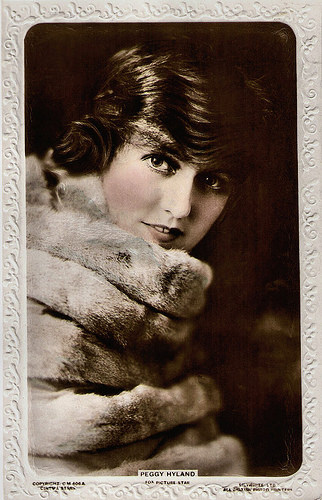
Peggy Hyland . British postcard in the Lilywhite Photographic series, no. CM 406a. Photo: William Fox.
Peggy Hyland (1884–1973) was an English film actress and director, who starred in more than 45 British and American silent films. She remained active in films until 1925. Peggy Hyland 's film credits number more than forty-five, in both British and American productions. Hyland wrote, produced, directed and starred in With Father's Help (Peggy Hyland, 1922) and she directed and starred in The Haunted Pearls (Peggy Hyland, 1924).
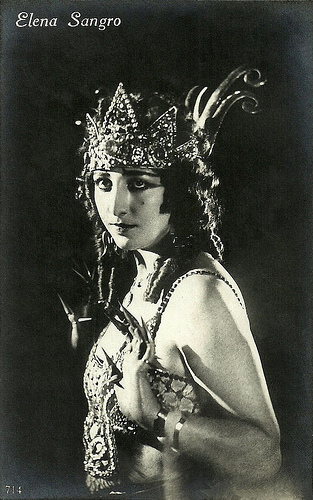
Elena Sangro . Italian postcard by Ed. A. Traldi, Milano, no. 714. Elena Sangro as Proserpina, wife of Pluto, king of the underworld, in the Italian silent film Maciste all'inferno/Maciste in Hell (Guido Brignone, 1925).
Elena Sangro (1896-1969) was one of the main actresses of the Italian cinema of the 1920s. In spite of the general film crisis then, she made one film after another. She was also one of the first female directors and she had a famous affair with the novelist, poet and playwright Gabriele D'Annunzio. Her last film appearance was a cameo in Federico Fellini's masterpiece 8½ (1963). Her last job was president of Associazione dei Pionieri del Cinema, an initiative begun in the early 1960s in order to saveguard this important part of film history.
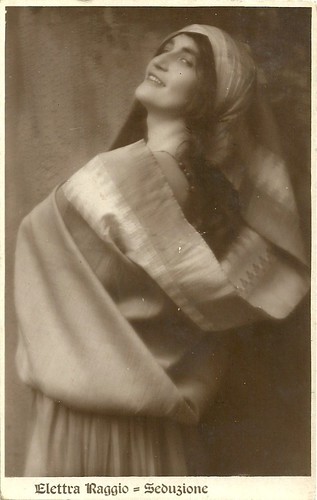
Elettra Raggio. Italian postcard. Elettra Raggio in the Italian silent film SeduzioneSeduction (1915). This title does not exist in the reference works, only the title Le due seduzioni/The Two Seductions (1916) which Raggio directed and in which she had the female lead as well, opposite Giovanni Donadio and Felice Minotti.
Elettra Raggio, pseudonym of Ginevra Francesca Rusconi (1887–1973), was an Italian film actress, director, scriptwriter and producer of the silent era. Raggio came from the theatre where she was 'first actress' in the company of Ermete Novelli . Of Genovese origin, she settled in Milan where she was hired in 1915 by the film production company Milano Films. There she acted in Verso l'arcobaleno/Towards the Rainbow (Eugenio Perego, 1916) - about a Belgian family menaced by the German invasion, the sensational film La cattiva stella/The Bad Star (Eugenio Perego, 1916) about a millionnaire (Ugo Gracci) who trades identity with a drowned man. In the same year, Raggio directed her first film at Milano: Le due seduzioni/The Two Seductions (1916), which she also scripted and produced. Also in 1916, Raggio founded her own film company within the aegis of Milano Film, which operated as distributor for Raggio Film. She produced two films. First came the poetic phantasy Primavera/Spring (Achille Mauzan, 1916), and then the romantic comedy Galeotto fu il mare.../The Sea was such a Lovemaker (Achille Mauzan, 1916. Mauzan also designed the posters for both films.

Sarah Bernhardt. French postcard. Sarah Bernhardt in Edmond Rostand's play L'Aiglon. The title role for Rostand's play was created by Bernhardt herself in the play's premiere on 15 March 1900 at the Théàtre Sarah Bernhardt in Paris.
Victoria Duckett at Women Pioneer Film Project: "She was among the first celebrities to engage with the motion picture, playing Hamlet in a one-minute film that formed part of Paul Decauville’s program for the Phono-Cinéma-Théâtre at the Paris Exposition of 1900. The first feature film that she released – Camille (1911) – was promoted the following year by the French American Film Company in Moving Picture World as “Making New Records for Selling States Rights”. A subsequent advertisement in the same trade press claimed that the film was “The Fastest Seller Ever Offered State Right Buyers”. As many film historians know, Bernhardt’s Queen Elizabeth (1912) was the Famous Players Company’s first release in the U.S. It similarly enjoyed success, helping to open the market for legitimate motion picture exhibition in the U.S. Queen Elizabeth thereby provided audiences with their first experience of the longer-playing narrative feature film."

Francesca Bertini . American postcard, monogram K Ltd. Francesca Bertini in Odette (Giuseppe De Liguoro, 1916).
Monica Dall’Asta at Women Pioneer Film Project : "Bertini’s different autobiographical interventions are consistent in reclaiming a creative as well as managerial role in the production of all her major star vehicles. Especially in the long interview recorded by Mingozzi, she credits herself not just for obtaining the rights to adapt 'Assunta Spina' from Di Giacomo, but, more importantly, she argues for directorial recognition for that film. This claim was later confirmed in a 1981 interview with her co-star, and the official director of the film, Gustavo Serena ."

Carmen Cartellieri . Austrian postcard by Iris Verlag, no. 989. Photo: Residenz Atelier, Wien.
Robert von Dassanowsky at Women Pioneer Film Project: "Carmen Cartellieri was born Franziska Ottilia Cartellieri in Prossnitz, Austria-Hungary, which is today Prostejov, Czech Republic, but spent her childhood in Innsbruck, Austria. In 1907, at age sixteen, she married the aristocratic artist-turned-director, Emanuel Ziffer Edler von Teschenbruck. Her husband and Cornelius Hintner, a cameraman from South Tyrol who had worked for Pathé in Paris and then as a director in Hungary, helped make her one of the most fashionable stars in German-language film of the 1920s. Using the stage name of Carmen Teschen, she appeared in several Hungarian silent films between 1918 and 1919 and made her Austrian film debut in Hintner’s Die Liebe vom Zigeunerstamme/The Gypsy Girl (1919), which she reportedly cowrote. Political changes in postwar Hungary made her relocate to Vienna where she returned to her exotic surname, suggesting to the press that she was born in Italy, and founded the Cartellieri-Film company in 1920 with her husband and Hintner."

Aud Egede Nissen . German postcard by Ross Verlag, no. 476/1, 1919-1924. Photo: A. Eberth, Berlin.
Gunnar Iversen at Women Pioneer Film Project: "During the 1910s and 1920s, Aud Egede-Nissen and her sisters Gerd and Ada made a name for themselves in the Nordic and German film industries as actors, producers, and directors. Like many female pioneers in the film industry, their work has been neglected. The contribution of the Egede-Nissen sisters, especially Aud, to silent film in the 1910s is remarkable given the odds they had to overcome as female producers in a male-dominated industry and the lack of tradition and experience in their home country, Norway."

Fabienne Fabrèges. Spanish postcard by Chocolate Salas-Sabadell.
Elena Nepoti at Women Pioneer Film Project: "Her film career, between 1910 and the mid-1920s, can be divided into three periods. Between 1910 and 1916, the actress worked in France for the Société des Établissements Gaumont. During World War I, she relocated to Italy, where she was immediately recognized as a leading actress by the Italian film industry, and, between 1916 and 1923, acted in two dozen films. In many of these films she is credited as the screenwriter, and for one of them, also as the director. Finally in the twenties she left the stage and screen in Italy and most likely moved to England, where it seems she carried out some further stage work, and then her career seems to have come to an end."

Diana Karenne . Italian postcard by Ed. Soc. Anon. It. Bettini, Roma.
Cristina Jandelli, Linda Del Gamba at Women Film Pioneer Project: " Diana Karenne was one of the most interesting personalities in the Italian and European film scenes of the early 1900s. Star, actress, intellectual, artist, director, screenwriter, and producer, she is representative of an effectual coexistence between two different ways of considering a woman’s role in both the film industry and in a society that was undergoing deep changes as to gender boundaries. Through her artistic career, she supported demands concerning female identity, widely felt between 1800 and 1900: in this very period, Europe was facing a process of modernization and large transformations at every social level. Karenne never took sides towards women’s emancipation movements, yet she opposed conservative morals and social conventions of that time through her personal, aesthetic, and professional choices, and helped to update the idea of cinema thanks to her bold artistic proposals and acting style."

Musidora . French cigarette card by Cigarettes Le Nil, no. 38. Photo: H. Manuel.
Annette Förster at Women Film Pioneer Project: "If we merely looked at contemporary advertisements and reviews, it would appear that Musidora had directed only two films in the silent era: Vicenta (1919), and La terre des taureaux/The Land of the Bulls (1924). These credits can be further substantiated by personal statements about the making of these films published by Musidora herself in contemporary periodicals. There, she additionally claimed credit for writing both scripts as well as for editing La terre des taureaux. However, on the two other films that were produced under the banner of her company, Société des Films Musidora, she credited as director her codirector Jacques Lasseyne. Even the richly illustrated publicity booklets of Pour Don Carlos/For Don Carlos (1921) and Soleil et ombre/Sun and Shadow (1922) listed Musidora only in the cast, and her article in the magazine Ève bore the telling title 'Comment j’ai tourné Don Carlos' or 'How I Acted in Don Carlos'. After the 1940s, however, Musidora began to claim the codirector and adaptation credits of these productions for herself, and these credits have now been accepted as definitive. Additionally, she added the credit for codirection, with Roger Lion, for La flamme cachée/The hidden flame (1918), which she mentioned in a 1950 article on her professional collaboration with her artistic mentor and longtime friend, Colette ."

Asta Nielsen . German postcard by Ross Verlag, no. 614/5. Photo: Union. Publicity still for Rausch/Intoxication (Ernst Lubitsch, 1919).
Julie Allen at Women Film Pioneer Project: "Frequently lauded as 'die Duse des Kinos' [the Duse of the cinema], as Poul Elsner noted in Weltrundschau in 1911, the Danish actress Asta Nielsen was the first major star of German silent film. She acted in more than seventy films, all but four of them made with German production companies, during the twenty-two years of her film career. The phenomenal success of her debut film, Afgrunden/The Abyss (1910) enabled her to become the first global film star under the new monopoly distribution system. From 1910 to 1914, she collaborated closely with director Urban Gad, who was also her first husband, under the auspices of Deutsche Bioscop and Projektions-AG “Union” (PAGU), and later established two film companies of her own. Although she struggled to come to terms with the director-centric turn of the film industry in Germany in the 1920s that restricted the artistic autonomy she had enjoyed in the 1910s, she made several of her most artistically impressive films, including several Weimar street films, during this period. In 1932, she acted in her only sound film, Unmögliche Liebe/Impossible Love, which was also her final film, aside from two documentaries about her made decades later."

Rosa Porten . German postcard in the Film Sterne series by Rotophot, no. 97/1. Photo: Karl Schenker, Berlin / Treumann- Larsson Film, Berlin.
Annette Förster at Women Film Pioneer Project: " Rosa Porten ’s work as a screenwriter, an actress, and a film director has been practically neglected in film history, but what she accomplished in the German silent cinema is truly noteworthy. In a two-decade career, from 1906 until 1928, she created a cinematic oeuvre that was substantial, original, versatile, and entertaining. The exact number of films to which Rosa Porten contributed is uncertain, but historical substantiation points to around forty titles. Between 1916 and 1919 alone, she wrote and co-directed at least twenty-four catching comedies and gripping social dramas and in most of them she played the protagonist. Even more notable in retrospect is that Porten’s stories often privileged the perspective of a female character who, with non-conformist pragmatism or jokey recalcitrance, seizes her chance to defy bourgeois conventions and role patterns."

Anny Ondrakova/Ondra . German postcard by Ross Verlag, no. 4250/1, 1929-1930.
Anny Ondra (1903-1987) was born as Anna Sophie Ondráková in Tarnów, Austria-Hungary, now Poland.. During the 1920s and 1930s she was a popular actress in Czech, Austrian and German comedies, and she was Alfred Hitchcock’s first ‘Blonde’. She was discovered at the age of 16 bij actor-director Karel (or Carl) Lamac. They starred together in the film Palimpsest (Joe Jencik, 1919). Lamac would also become her first husband. From 1919 on Anny Ondra often worked together with Lamac as her director and/or her co-star dor their own production company. With their film Gilly po prve v Praze/Gilly zum ersten Mal in Prag/Gilly for the First Time in Prague (Carl Lamac, 1920) she became a big comedy star in the silent Czechoslovakian and Austrian cinema.

Rita Sacchetto . German Postcard by Verlag Hermann Leiser, Berlin, no. 7185. Collection: Didier Hanson.
German actress and dancer Rita Sacchetto (1879-1959) was in the 1910s a star of the Danish Nordisk Film Company. Nordisk had hired Sacchetto to star in films for the astonishing salary of 7,000 kroner per picture, but she made many quite successful films including Fra Fryste til Knejpevaert/The Gambler's Wife (Holger-Madsen, 1913) and Den Skønne Evelyn/Evelyn the Beautiful (A.W. Sandberg, 1916) with a script by Carl Theodor Dreyer. According to Karl Toepfer in his study 'Empire of Ecstasy: Nudity and Movement in German Body Culture, 1910-1935' "Sacchetto exuded a dusky, melancholy beauty that seemed even more refined and aristocratic, a 'breeze of perfume,' when displayed in opulent historical costumes. Although she excluded modern paintings of women from her graceful productions, she was probably the first to use silent film as a model for composing dances."

Fern Andra . German postcard by Rotophot in the Film Sterne series, no. 512/6. Photo: Fern Andra Atelier. Fern Andra in Eine Motte flog zum Licht (Fern Andra, 1915).
'Modern' American Fern Andra (1893-1974) became one of the most popular film stars of the German cinema in the 1910s and early 1920s. In her films she mastered tightroping, riding a horse without a saddle, driving cars and motorcycles, bobsleighing, and even boxing. She started her own company, even directing her own films. Right during the First World War, Fern made one film after another, always about women who are victims of cruel events but who are also determined to settle matters. These films included Eine Motte floh zum Licht/A Moth Flew To The Light (Fern Andra, 1915), and Drohende Wolken am Firmament/Threatening Clouds in the Sky (Fern Andra, 1918). Moonlight romance, theatres burning down, and luxurious parties in aristocratic milieux. Unfortunately most of these films were never exported because of the war, and most are lost now.

Erna Morena . German postcard by Photochemie, no. K . 1741. Photo: Alex Binder, Berlin.
Although her name is now largely forgotten, Erna Morena (1885-1962) appeared in about 120 films during five decades. She had an enormous career in the German silent cinema of the 1910s and 1920s as both an actress, producer and screenwriter, and until the mid-1930s she was regularly performing in German sound films. In 1918 she founded in Berlin, Erna Morena Film GmbH, supported by some friends as partners. She produced films like Colomba (1918) with Werner Krauss , and Die 999. Nacht/The 999th Night (1919/1920) with Hans Albers . Because of the economic crisis after the German November revolution of 1918-1919, she had to stop producing after two years.

Hella Moja . German postcard in the Film-Sterne series by Rotophot, no. 547/1. Hella Moja in the German silent film Heide-Gretel (Otto Rippert, 1918), produced by the Decla-Filmgellschaft (Eric Pommer).
During the First World War and the following years Hella Moja (1890-1951) was one of the most popular stars of the German silent cinema. There was even a Hella Moja serial and in 1918 she founded her own film company. The Hella Moja Filmgesellschaft would produce 16 films. Her first production was Wundersam ist das Märchen der Liebe/Wondrous is the Fairy Tale of Love (Leo Connard, 1918) with Ernst Hofmann , for which the critics especially praised her acting. Another successful production was Die Augen von Jade/The Eyes of Jade (Iwa Raffay, 1918). In Figaros Hochzeit/The Marriage of Figaro (Max Mack, 1920) based on the play by Pierre Augustin Caron de Beaumarchais, she was again impressive as Cherubino - Figaros page opposite Alexander Moissi as Figaro.

Wanda Traumann . German postcard in the Film Sterne series by Rotophot, no. 85/3. Photo: Karl Schenker / Messter Film, Berlin.
Wanda Traumann (1889–1926) belonged to the most popular stars of the German cinema before the first World War. In 1912, together with actor-director Viggo Larsen and her husband, Karl Treumann, she founded her own production company Treumann-Larsen Film GmbH in Berlin. Officially, Wanda Treumann ’s husband was indicated as owner of the firm. As she said herself in Lichtbild-Theater, no. 41, 1912: "Then we – my master and partner in film, Mr. Oberregisseur Viggo Larsen and me – became fully independent. And so we are now: for the production of our new 'Treumann-Larsen-series', we develop the negatives ourselves which we shoot in our own film studio with our own cast and crew."

Olga Tschechowa . German postcard by Ross Verlag, no. 1590/3, 1927-1928. Photo: Ufa.
Dignified German-Russian actress Olga Tschechowa (1897-1980) was one of the most popular stars of the silent film era. She played in more than 40 silent films, including the classic comedy Un Chapeau de Paille d'Italie/An Italian Straw Hat (René Clair, 1927), Moulin Rouge (Ewald André Dupont, 1928), and Diane (Erich Waschneck, 1929), which was produced by her own company Tschechowa Film. She remained a mysterious person throughout her life, and was reportedly a Russian agent in Nazi Germany.

Former Kingdom of Yugoslavia (now Croatian) postcard. Photo: Croatia Film. Jugoslavija Film, Zagreb, No. 11. Milica Mihicic, Zorka Grund and Bogumila Vilhar in the film Dvije sirote/ Dvije sirotice/The Two Orphans (Alfred Grinhut [listed as Alfred Grünhut], 1919), starring Zorka Grund. The film is based on the famous French play 'Les deux orphelines' by Adolphe d'Ennery and Eugène Cormon (1874).
Zorka Kremzar, born Zorka Grund (1900 -?), was a Croatian film actress. She was the daughter of Arnošt Grund, a director of Czech origin, and sister of Milada Grund, who performed under the pseudonym of Milada Tana. Zorka Grund later became a filmmaker.

Peggy Hyland . British postcard in the Lilywhite Photographic series, no. CM 406a. Photo: William Fox.
Peggy Hyland (1884–1973) was an English film actress and director, who starred in more than 45 British and American silent films. She remained active in films until 1925. Peggy Hyland 's film credits number more than forty-five, in both British and American productions. Hyland wrote, produced, directed and starred in With Father's Help (Peggy Hyland, 1922) and she directed and starred in The Haunted Pearls (Peggy Hyland, 1924).

Elena Sangro . Italian postcard by Ed. A. Traldi, Milano, no. 714. Elena Sangro as Proserpina, wife of Pluto, king of the underworld, in the Italian silent film Maciste all'inferno/Maciste in Hell (Guido Brignone, 1925).
Elena Sangro (1896-1969) was one of the main actresses of the Italian cinema of the 1920s. In spite of the general film crisis then, she made one film after another. She was also one of the first female directors and she had a famous affair with the novelist, poet and playwright Gabriele D'Annunzio. Her last film appearance was a cameo in Federico Fellini's masterpiece 8½ (1963). Her last job was president of Associazione dei Pionieri del Cinema, an initiative begun in the early 1960s in order to saveguard this important part of film history.

Elettra Raggio. Italian postcard. Elettra Raggio in the Italian silent film SeduzioneSeduction (1915). This title does not exist in the reference works, only the title Le due seduzioni/The Two Seductions (1916) which Raggio directed and in which she had the female lead as well, opposite Giovanni Donadio and Felice Minotti.
Elettra Raggio, pseudonym of Ginevra Francesca Rusconi (1887–1973), was an Italian film actress, director, scriptwriter and producer of the silent era. Raggio came from the theatre where she was 'first actress' in the company of Ermete Novelli . Of Genovese origin, she settled in Milan where she was hired in 1915 by the film production company Milano Films. There she acted in Verso l'arcobaleno/Towards the Rainbow (Eugenio Perego, 1916) - about a Belgian family menaced by the German invasion, the sensational film La cattiva stella/The Bad Star (Eugenio Perego, 1916) about a millionnaire (Ugo Gracci) who trades identity with a drowned man. In the same year, Raggio directed her first film at Milano: Le due seduzioni/The Two Seductions (1916), which she also scripted and produced. Also in 1916, Raggio founded her own film company within the aegis of Milano Film, which operated as distributor for Raggio Film. She produced two films. First came the poetic phantasy Primavera/Spring (Achille Mauzan, 1916), and then the romantic comedy Galeotto fu il mare.../The Sea was such a Lovemaker (Achille Mauzan, 1916. Mauzan also designed the posters for both films.
Published on May 24, 2019 22:00
May 23, 2019
Fritz Wagner
German actor Fritz Wagner (1915-1982) was a handsome star in the European cinema of the 1940s and 1950s. From 1938 to 1976, he appeared in more than sixty films and TV productions, both in Eastern Germany and in West-Germany.
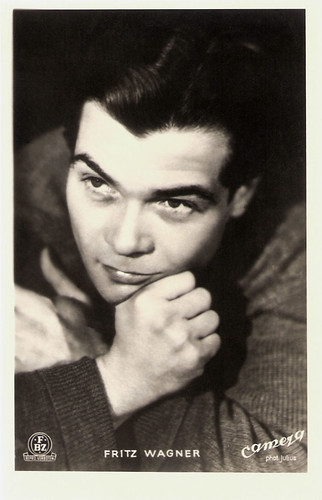
German postcard by Film Bild Zentrale (FBZ). Photo: Julius / Camera.
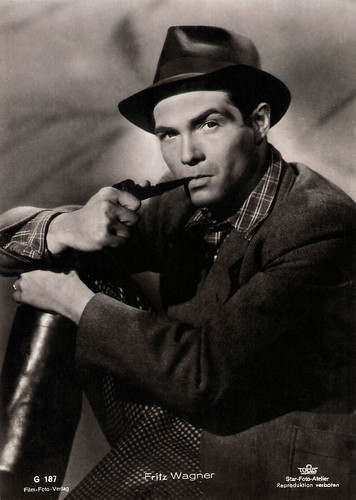
German postcard by Film-Foto-Verlag, no. C 187. Photo: Star-Foto-Atelier / Tobis. Publicity still for Der Erbförster/The hereditary ranger (Alois Johannes Lippl, 1945).

German postcard by Kitt Fotokarten, München. Photo: Kurt Julius / Camera Film / Herzog. Publicity still for In jenen Tagen/Seven Journeys (Helmut Käutner, 1947).
One of the faces of the West-German Trümmerfilme
Friedrich Karl Wagner was born in 1915 in Heilbronn, Baden-Württemberg, Germany. His father, Karl Friedrich Wagner, worked in a cinema.
Fritz attended drama classes from Elly Förster. Then followed first parts in the theatres in Stuttgart, München and Berlin, at the Volksbühne and Hebbel-Theater. In 1938, Fritz started his film career with bit roles, including one in the Nazi propaganda film Stukas (Karl Ritter, 1941).
Wagner played supporting roles in the drama Mit den Augen einer Frau/With the Eyes of a Woman (Karl Georg Külb, 1942) starring the sisters Ada and Olga Tschechowa , and the comedy Sophienlund (Heinz Rühmann, 1943) starring Harry Liedtke .
After the war, he played a leading role in the drama Freies Land/A Free Country (Milo Harbich, 1946) the second film of the newly founded DEFA studio in the Soviet occupation zone which later became East Germany. The propaganda film portrayed the effects of land reforms brought in by the Soviet authorities.
It would be the only DEFA film until the mid-1950s that dealt with the hardships of East-Germany's rural life, and was heavily influenced by the Italian Neorealism of that time. Most people in the film weren't professional actors but farmers. The film proved to be very unsuccessful on its release.
Between 1946 and 1949, Wagner was also one of the faces of the West-German Trümmerfilme, produced in Hamburg in the British Zone in the wake of Germany's defeat during World War II. He appeared in one of the episodes of In jenen Tagen/Seven Journeys (Helmut Käutner, 1947), about the story of a car and its seven owners during the years of the Third Reich.
The film's objective was to highlight the private resistance of various figures to the Nazis even while they publicly accepted the repression of Nazi society. In jenen Tagen was well received by the German public and gives an early display of the talent of Helmut Käutner , who both directed and wrote the film.
Wagner also had a supporting part in the romantic comedy Film ohne Titel/Film Without Title (Rudolf Jugert, 1948), starring Hans Söhnker and Hildegard Knef . It is an interesting reflection about the rights to be entertained after WWII: which stories can be told, when all stories seem to have been finished? It shows the attempts of a film crew to shoot a film.
Herbert Schwaab at IMDb : "The film is entertaining and modern as well. Unfortunately questions of film form were not to be touched again until the seventies." For the DEFA, he also played a leading role in the war drama Die Brücke/The Bridge (Arthur Pohl, 1949), and in Der Kahn der fröhlichen Leute (Hans Heinrich, 1950) which sold more than 4,100,000 tickets.
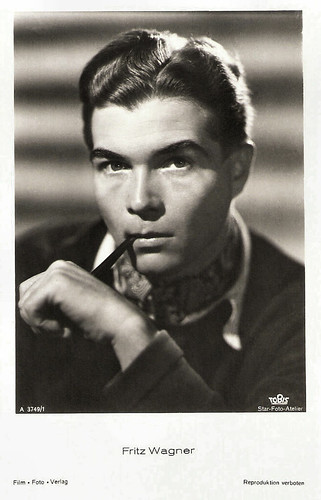
German postcard by Film-Foto-Verlag, no. A 3749/1, 1941-1944. Photo: Star-Foto-Atelier / Tobis.
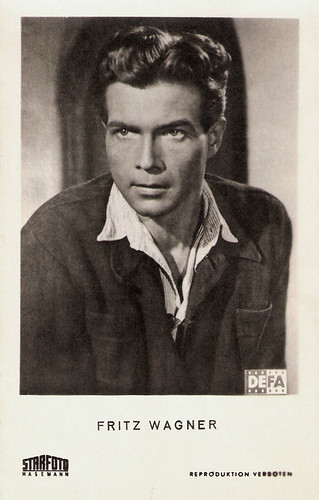
German postcard by Starfoto Hasemann. Photo: DEFA. Publicity still for Freies Land/A Free Country (Milo Harbich, 1946).
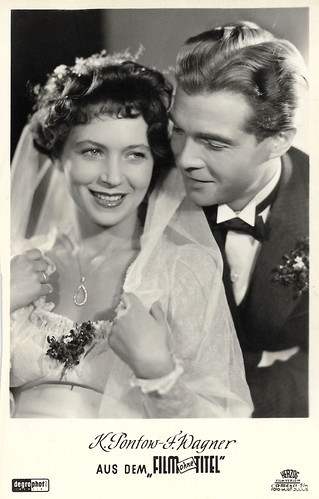
German postcard by Degro Phot., Berlin, no. C 187. Photo: Herzog Filmverleih / Camera Film / Kurt Julius. Fritz Wagner and Käte Pontow in Film ohne Titel/Film Without Title (Rudolf Jugert, 1948).
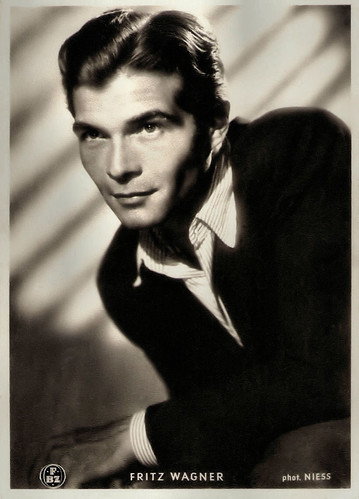
German postcard by Film Bild Zentrale (FBZ). Photo: Niess.
Big City Secret
During the 1950s, Fritz Wagner was one of the well known faces of the German and Austrian cinema. He starred opposite Ingrid Lutz in the crime film Großstadtgeheimnis/Big City Secret (Leo de Laforgue, 1952).
He often had supporting parts such as in the satire Der Hauptmann und sein Held/The Captain and His Hero (Max Nosseck, 1955) or in Eine Frau genügt nicht?/One Woman Is Not Enough? (Ulrich Erfurth, 1955), with Hilde Krahl and Hans Söhnker .
At the end of the 1950s, his roles became smaller. His later films include the crime drama Banktresor 713/Bank Vault 713 (Werner Klingler, 1957) with Martin Held and Hardy Krüger , and the crime film Der Greifer/The Copper (Eugen York, 1958) with Hans Albers .
His final feature film was the Theo Lingen comedy Bei Pichler stimmt die Kasse nicht/Pichler's Books Are Not in Order (Hans Quest, 1961).
During the 1960s he worked for television, and he was last seen on screen in the mini-series Alle Jahre wieder: Die Familie Semmeling/Every year again: the Semmeling family (1976). From 1945 on, Wagner worked often for the radio, and appeared in many radio plays till 1970. He also gave acting classes.
Wagner was probably homosexual. Gottfried Lorenz describes in his book 'Töv, di schiet ik an: Beiträge zur Hamburger Schwulengeschichte' how he was named in a 'theatre scandal' around actor Karl Stoll in 1941 and 1942. I guess his sexuality probably hurt his film career during the 1950s.
Fritz Wagner died of cancer in 1982 in Bonn, North Rhine-Westphalia, West Germany. He was 66.
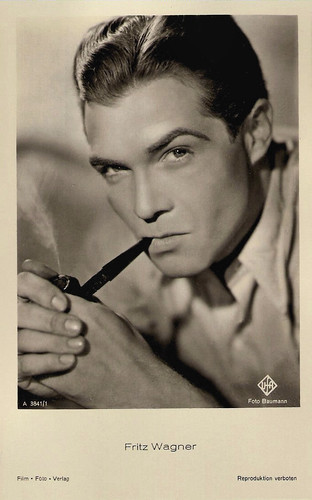
German postcard by Film-Foto-Verlag, no. A 3841/1, 1941-1944. Photo: Baumann / Ufa.
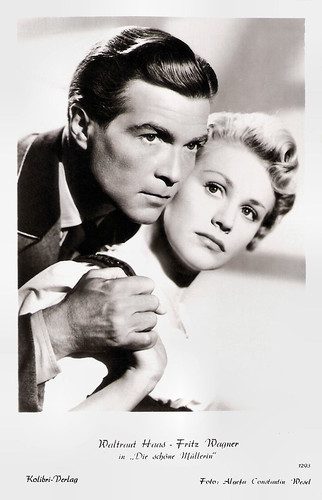
German postcard by Kolibri-Verlag, no. 1293. Photo: Algefa / Constantin / Wesel. Publicity still for Die Schöne Müllerin/The beautiful Miller (Wolfgang Liebeneiner, 1954) with Waltraut Haas .
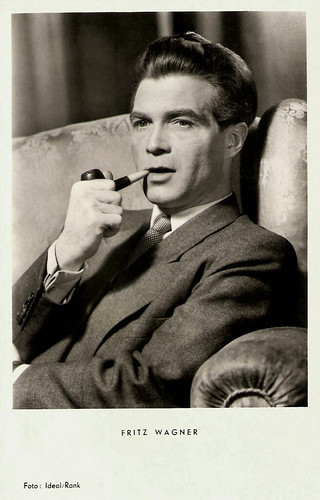
German postcard by Kunst und Bild, Berlin, no. A 389. Photo: Ideal / Rank.
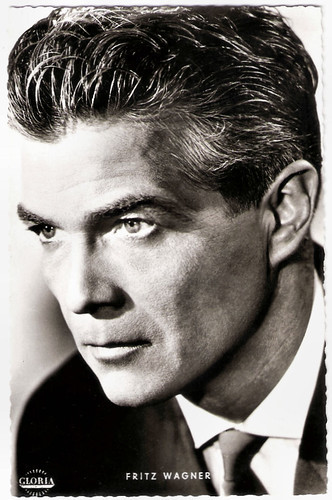
German postcard by Kunst und Bild, Berlin, no. T 820. Photo: Wega / Gloria-Film / Bayer. Publicity still for Das alte Försterhaus/The old forester's house (Harald Philipp, 1956).
Sources: Gottfried Lorenz (Töv, di schiet ik an: Beiträge zur Hamburger Schwulengeschichte), Wikipedia (German) and .

German postcard by Film Bild Zentrale (FBZ). Photo: Julius / Camera.

German postcard by Film-Foto-Verlag, no. C 187. Photo: Star-Foto-Atelier / Tobis. Publicity still for Der Erbförster/The hereditary ranger (Alois Johannes Lippl, 1945).

German postcard by Kitt Fotokarten, München. Photo: Kurt Julius / Camera Film / Herzog. Publicity still for In jenen Tagen/Seven Journeys (Helmut Käutner, 1947).
One of the faces of the West-German Trümmerfilme
Friedrich Karl Wagner was born in 1915 in Heilbronn, Baden-Württemberg, Germany. His father, Karl Friedrich Wagner, worked in a cinema.
Fritz attended drama classes from Elly Förster. Then followed first parts in the theatres in Stuttgart, München and Berlin, at the Volksbühne and Hebbel-Theater. In 1938, Fritz started his film career with bit roles, including one in the Nazi propaganda film Stukas (Karl Ritter, 1941).
Wagner played supporting roles in the drama Mit den Augen einer Frau/With the Eyes of a Woman (Karl Georg Külb, 1942) starring the sisters Ada and Olga Tschechowa , and the comedy Sophienlund (Heinz Rühmann, 1943) starring Harry Liedtke .
After the war, he played a leading role in the drama Freies Land/A Free Country (Milo Harbich, 1946) the second film of the newly founded DEFA studio in the Soviet occupation zone which later became East Germany. The propaganda film portrayed the effects of land reforms brought in by the Soviet authorities.
It would be the only DEFA film until the mid-1950s that dealt with the hardships of East-Germany's rural life, and was heavily influenced by the Italian Neorealism of that time. Most people in the film weren't professional actors but farmers. The film proved to be very unsuccessful on its release.
Between 1946 and 1949, Wagner was also one of the faces of the West-German Trümmerfilme, produced in Hamburg in the British Zone in the wake of Germany's defeat during World War II. He appeared in one of the episodes of In jenen Tagen/Seven Journeys (Helmut Käutner, 1947), about the story of a car and its seven owners during the years of the Third Reich.
The film's objective was to highlight the private resistance of various figures to the Nazis even while they publicly accepted the repression of Nazi society. In jenen Tagen was well received by the German public and gives an early display of the talent of Helmut Käutner , who both directed and wrote the film.
Wagner also had a supporting part in the romantic comedy Film ohne Titel/Film Without Title (Rudolf Jugert, 1948), starring Hans Söhnker and Hildegard Knef . It is an interesting reflection about the rights to be entertained after WWII: which stories can be told, when all stories seem to have been finished? It shows the attempts of a film crew to shoot a film.
Herbert Schwaab at IMDb : "The film is entertaining and modern as well. Unfortunately questions of film form were not to be touched again until the seventies." For the DEFA, he also played a leading role in the war drama Die Brücke/The Bridge (Arthur Pohl, 1949), and in Der Kahn der fröhlichen Leute (Hans Heinrich, 1950) which sold more than 4,100,000 tickets.

German postcard by Film-Foto-Verlag, no. A 3749/1, 1941-1944. Photo: Star-Foto-Atelier / Tobis.

German postcard by Starfoto Hasemann. Photo: DEFA. Publicity still for Freies Land/A Free Country (Milo Harbich, 1946).

German postcard by Degro Phot., Berlin, no. C 187. Photo: Herzog Filmverleih / Camera Film / Kurt Julius. Fritz Wagner and Käte Pontow in Film ohne Titel/Film Without Title (Rudolf Jugert, 1948).

German postcard by Film Bild Zentrale (FBZ). Photo: Niess.
Big City Secret
During the 1950s, Fritz Wagner was one of the well known faces of the German and Austrian cinema. He starred opposite Ingrid Lutz in the crime film Großstadtgeheimnis/Big City Secret (Leo de Laforgue, 1952).
He often had supporting parts such as in the satire Der Hauptmann und sein Held/The Captain and His Hero (Max Nosseck, 1955) or in Eine Frau genügt nicht?/One Woman Is Not Enough? (Ulrich Erfurth, 1955), with Hilde Krahl and Hans Söhnker .
At the end of the 1950s, his roles became smaller. His later films include the crime drama Banktresor 713/Bank Vault 713 (Werner Klingler, 1957) with Martin Held and Hardy Krüger , and the crime film Der Greifer/The Copper (Eugen York, 1958) with Hans Albers .
His final feature film was the Theo Lingen comedy Bei Pichler stimmt die Kasse nicht/Pichler's Books Are Not in Order (Hans Quest, 1961).
During the 1960s he worked for television, and he was last seen on screen in the mini-series Alle Jahre wieder: Die Familie Semmeling/Every year again: the Semmeling family (1976). From 1945 on, Wagner worked often for the radio, and appeared in many radio plays till 1970. He also gave acting classes.
Wagner was probably homosexual. Gottfried Lorenz describes in his book 'Töv, di schiet ik an: Beiträge zur Hamburger Schwulengeschichte' how he was named in a 'theatre scandal' around actor Karl Stoll in 1941 and 1942. I guess his sexuality probably hurt his film career during the 1950s.
Fritz Wagner died of cancer in 1982 in Bonn, North Rhine-Westphalia, West Germany. He was 66.

German postcard by Film-Foto-Verlag, no. A 3841/1, 1941-1944. Photo: Baumann / Ufa.

German postcard by Kolibri-Verlag, no. 1293. Photo: Algefa / Constantin / Wesel. Publicity still for Die Schöne Müllerin/The beautiful Miller (Wolfgang Liebeneiner, 1954) with Waltraut Haas .

German postcard by Kunst und Bild, Berlin, no. A 389. Photo: Ideal / Rank.

German postcard by Kunst und Bild, Berlin, no. T 820. Photo: Wega / Gloria-Film / Bayer. Publicity still for Das alte Försterhaus/The old forester's house (Harald Philipp, 1956).
Sources: Gottfried Lorenz (Töv, di schiet ik an: Beiträge zur Hamburger Schwulengeschichte), Wikipedia (German) and .
Published on May 23, 2019 22:00
May 22, 2019
Isabelle Corey
French film actress Isabelle Corey (1939-2011) appeared in French and Italian films in the 1950s and early 1960s. Her best film was her first, the Film Noir Bob le flambeur/Bob the Gambler (Jean-Pierre Melville, 1956).
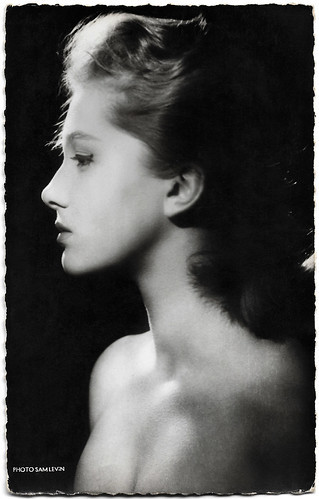
French postcard by Editions du Globe, Paris, no. 618. Photo: Sam Lévin.
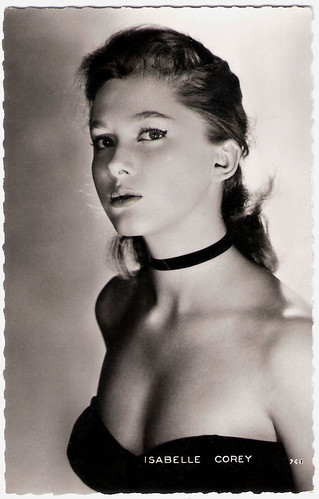
French postcard Editions P.I., offered by Les Carbones Korès 'Carboplane', no. 748. Photo: Sam Lévin.

German postcard by ISV, no G 3.
Young Femme Fatale
Isabelle Corey was born in Metz, France in 1939. Corey started modelling in Paris in her teens for magazines such as Jardin des Modes, Elle and Madame Figaro.
She was discovered by director Jean-Pierre Melville, walking in the Latin Quarter of Paris where she lived with her parents.
Her film debut was his Film Noir Bob le flambeur/Bob the Gambler (1956, Jean-Pierre Melville) starring Roger Duchesne as an old gangster and Corey played his young femme fatale, Anne. When Anne is down on her luck Bob takes her under his wing, hoping to steer her away from a life of prostitution. But Anne begins a love affair with Paulo (Daniel Cauchy), one of Bob’s young associates.
Alice Liddel at IMDb writes: “Isabelle Corey is unprecedented among all film heroines, her amoral, seemingly indifferent sexuality far more suggestive and powerful than her contemporary, Bardot's”.
That same year Corey appeared opposite Brigitte Bardot in the hit Et Dieu... créa la femme/And God created Woman (Roger Vadim, 1956), which made a superstar of BB.
The late James Travers wrote at the former website Films de France : “Vadim was so impressed with his work that he remade the film in the late 1980s, but, lacking the presence of Bardot, the result was scarcely a patch on the original. The original Et Dieu... créa la femme succeeded, despite the shallowness of its subject matter, because it happened at just the right time. Its impact on French cinema can only be guessed at, but it was probably very considerable indeed”.
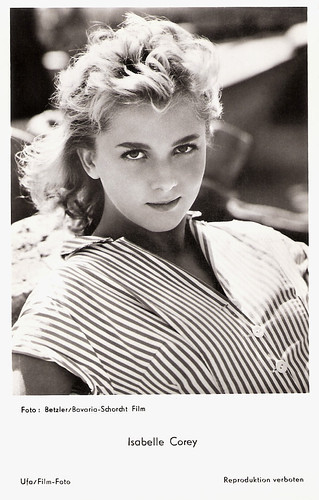
German postcard by UFA, no. FK 3372. Retail price: 25 Pfg. Photo: Betzler / Bavaria-Schorcht Film.
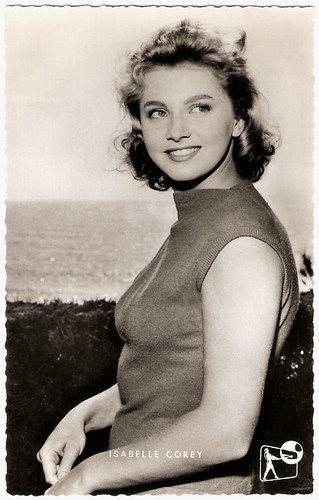
German postcard by Kunst und Bild, Berlin-Charlottenburg, no. I 270. Photo: Rank. Publicity still for Souvenir d'Italie/It Happened in Rome (1957).
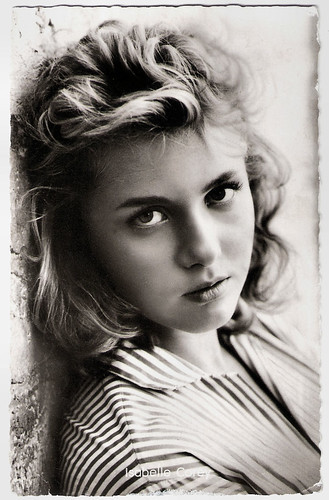
German postcard by Kolibri-Verlag, Mionden/Westf., no. 2363. Photo: Schorcht / Betzler. Publicity still for La ragazza della salina/Sand, Love and Salt (Frantisek Cáp, 1957).
It Happened in Rome
The following years Isabelle Corey played in several French-Italian coproductions, filmed in Italy. Among them were the romantic comedies Vacanze a Ischia/Holiday Island (Mario Camerini, 1957) with Vittorio de Sica , Souvenir d'Italie/It Happened in Rome (Antonio Pietrangeli, 1957), and Adorabili e bugiarde/Adorable and a Liar (Nunzio Malasomma, 1958).
More interesting were the comedies Giovani mariti/Young Husbands (Mauro Bolognini, 1958) based on a screenplay by Pier Paolo Pasolini, and Amore a prima vista/Love at First Sight (Franco Rossi, 1958) with Walter Chiari .
Three years later, she reunited with director Mauro Bolognini for La Giornata balorda/A Crazy day (Mauro Bolognini, 1961) which featured Jean Sorel and Lea Massari. Again the script was written by Pier Paolo Pasolini, before he became a director himself. It is a black-and-white film about the lower class of Rome, based on a novel by Alberto Moravia.
Corey then worked with the future horror master Mario Bava at the Peplum spectacle L'Ultimo dei Vikinghi/Last of the Vikings (Giacomo Gentilomo, Mario Bava, 1961) starring Cameron Michell in the good-guy role and Edmund Purdom as the mincing, giggling villain.
That year she also worked with maestro Roberto Rossellini on the costume drama Vanina Vanini/The Betrayer (Roberto Rossellini, 1961) starring Sandra Milo and Laurent Terzieff . This is her last film according to IMDb .
AllMovie also lists the Italian/Spanish Peplum Il Gladiatore Invincibile/Invincible Gladiators (Alberto de Martino, Robert Mauri, 1963) with Richard Harrison.
After only 16 films Isabelle Corey’s film career was over. She died of cancer in Crozon, France in 2011.

Small Romanian collectors card. Photo: publicity still for Adorabili e bugiarde/Adorable and a Liar (Nunzio Malasomma, 1958) with Ingeborg Schöner, Isabelle Corey and Eloisa Cianni .
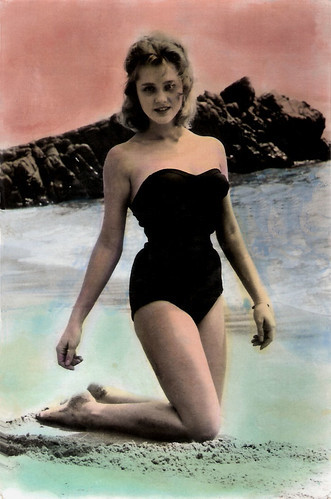
Yugoslavian postcard by Studio Sombor, no. 216.

Italian postcard by Turismofoto, no. 17. Sent by mail in 1958.
Trailer for Bob le flambeur/Bob the Gambler (1956). Source: CynicalC1 (YouTube).
Sources: James Travers (Films de France - now offline), AllMovie, Wikipedia and .

French postcard by Editions du Globe, Paris, no. 618. Photo: Sam Lévin.

French postcard Editions P.I., offered by Les Carbones Korès 'Carboplane', no. 748. Photo: Sam Lévin.

German postcard by ISV, no G 3.
Young Femme Fatale
Isabelle Corey was born in Metz, France in 1939. Corey started modelling in Paris in her teens for magazines such as Jardin des Modes, Elle and Madame Figaro.
She was discovered by director Jean-Pierre Melville, walking in the Latin Quarter of Paris where she lived with her parents.
Her film debut was his Film Noir Bob le flambeur/Bob the Gambler (1956, Jean-Pierre Melville) starring Roger Duchesne as an old gangster and Corey played his young femme fatale, Anne. When Anne is down on her luck Bob takes her under his wing, hoping to steer her away from a life of prostitution. But Anne begins a love affair with Paulo (Daniel Cauchy), one of Bob’s young associates.
Alice Liddel at IMDb writes: “Isabelle Corey is unprecedented among all film heroines, her amoral, seemingly indifferent sexuality far more suggestive and powerful than her contemporary, Bardot's”.
That same year Corey appeared opposite Brigitte Bardot in the hit Et Dieu... créa la femme/And God created Woman (Roger Vadim, 1956), which made a superstar of BB.
The late James Travers wrote at the former website Films de France : “Vadim was so impressed with his work that he remade the film in the late 1980s, but, lacking the presence of Bardot, the result was scarcely a patch on the original. The original Et Dieu... créa la femme succeeded, despite the shallowness of its subject matter, because it happened at just the right time. Its impact on French cinema can only be guessed at, but it was probably very considerable indeed”.

German postcard by UFA, no. FK 3372. Retail price: 25 Pfg. Photo: Betzler / Bavaria-Schorcht Film.

German postcard by Kunst und Bild, Berlin-Charlottenburg, no. I 270. Photo: Rank. Publicity still for Souvenir d'Italie/It Happened in Rome (1957).

German postcard by Kolibri-Verlag, Mionden/Westf., no. 2363. Photo: Schorcht / Betzler. Publicity still for La ragazza della salina/Sand, Love and Salt (Frantisek Cáp, 1957).
It Happened in Rome
The following years Isabelle Corey played in several French-Italian coproductions, filmed in Italy. Among them were the romantic comedies Vacanze a Ischia/Holiday Island (Mario Camerini, 1957) with Vittorio de Sica , Souvenir d'Italie/It Happened in Rome (Antonio Pietrangeli, 1957), and Adorabili e bugiarde/Adorable and a Liar (Nunzio Malasomma, 1958).
More interesting were the comedies Giovani mariti/Young Husbands (Mauro Bolognini, 1958) based on a screenplay by Pier Paolo Pasolini, and Amore a prima vista/Love at First Sight (Franco Rossi, 1958) with Walter Chiari .
Three years later, she reunited with director Mauro Bolognini for La Giornata balorda/A Crazy day (Mauro Bolognini, 1961) which featured Jean Sorel and Lea Massari. Again the script was written by Pier Paolo Pasolini, before he became a director himself. It is a black-and-white film about the lower class of Rome, based on a novel by Alberto Moravia.
Corey then worked with the future horror master Mario Bava at the Peplum spectacle L'Ultimo dei Vikinghi/Last of the Vikings (Giacomo Gentilomo, Mario Bava, 1961) starring Cameron Michell in the good-guy role and Edmund Purdom as the mincing, giggling villain.
That year she also worked with maestro Roberto Rossellini on the costume drama Vanina Vanini/The Betrayer (Roberto Rossellini, 1961) starring Sandra Milo and Laurent Terzieff . This is her last film according to IMDb .
AllMovie also lists the Italian/Spanish Peplum Il Gladiatore Invincibile/Invincible Gladiators (Alberto de Martino, Robert Mauri, 1963) with Richard Harrison.
After only 16 films Isabelle Corey’s film career was over. She died of cancer in Crozon, France in 2011.

Small Romanian collectors card. Photo: publicity still for Adorabili e bugiarde/Adorable and a Liar (Nunzio Malasomma, 1958) with Ingeborg Schöner, Isabelle Corey and Eloisa Cianni .

Yugoslavian postcard by Studio Sombor, no. 216.

Italian postcard by Turismofoto, no. 17. Sent by mail in 1958.
Trailer for Bob le flambeur/Bob the Gambler (1956). Source: CynicalC1 (YouTube).
Sources: James Travers (Films de France - now offline), AllMovie, Wikipedia and .
Published on May 22, 2019 22:00
May 21, 2019
Nur ein Schmetterling (1918)
Hella Moja starred in the German silent film Nur ein Schmetterling/Only a Butterfly (Iwa Raffay, 1918). Her own film company, Hella-Moja-Film, produced the film. Rotophot published a series of five sepia postcards of the film in their Film Sterne series, of which we cound find only four. We'll keep looking!
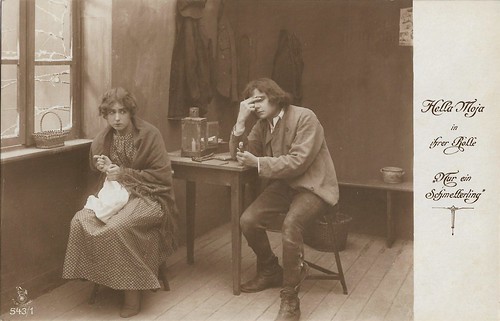
German postcard by Rotophot in the Film Sterne series, no. 543/1. Photo: Hella-Moja-Film. Hella Moja in Nur ein Schmetterling/Only a Butterfly (Iwa Raffay, 1918).
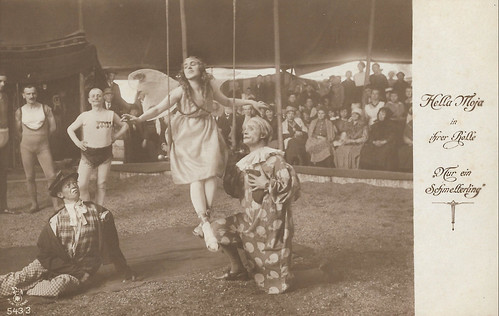
German postcard by Rotophot in the Film Sterne series, no. 543/3. Photo: Hella-Moja-Film. Hella Moja in Nur ein Schmetterling/Only a Butterfly (Iwa Raffay, 1918).
Countess or Damsel
Little is known about Nur ein Schmetterling/Only a Butterfly (Iwa Raffay, 1918). IMDb mentions that Iva (other sources write Iwa) Raffay was both director and scriptwriter, and that the cast also included Alfred Abel , Karl Falkenberg, Josef Ewald and Ernst Hofmann . We did not recognise them on the postcards.
Hella Moja was only 22 at the time. Since 1915, she had worked for pioneer studios like Messter, Union and Terra-Film, and had excelled in short silent melodramas like Die weiße Rose/The White Rose (Franz Hofer, 1915) opposite Erna Morena , Der Schwur der Renate Rabenau/The Vow of Renate Rabenau (Otto Rippert, 1916), Der Fremde/The Stranger (Otto Rippert, 1917) with Werner Krauss and Das verwunschene Schloss/The Enchanted Castle (Otto Rippert, 1918) again with Krauss.
In her films Hella Moja often played a countess or a damsel. With success. There was a Hella Moja serial, and in 1918 she could found her own film company, the Hella Moja Filmgesellschaft, in Berlin. Nur ein Schmetterling was the third production of her film company. 13 more films would follow until 1923. From then on her acting style was seen as old-fashioned and she started to focus on script-writing.
IMDb also mentions that Nur ein Schmetterling premiered in June 1918. So, the First World War or the Great War, was still going on. Germany was falling apart at home. Anti-war marches became frequent and morale in the army fell. In November the war finally ended.
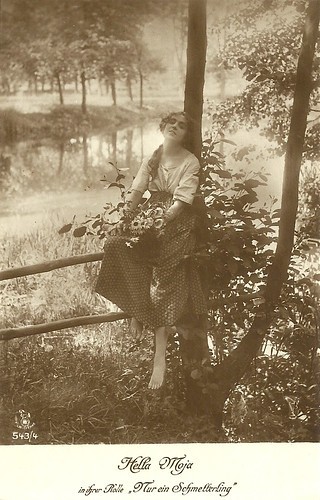
German postcard by Rotophot in the Film Sterne series, no. 543/4. Photo: Hella-Moja-Film. Hella Moja in Nur ein Schmetterling/Only a Butterfly (Iwa Raffay, 1918).

German postcard by Rotophot in the Film Sterne series, no. 543/5. Photo: Hella-Moja-Film. Hella Moja in Nur ein Schmetterling/Only a Butterfly (Iwa Raffay, 1918).
Sources: Wikipedia (German) and IMDb.

German postcard by Rotophot in the Film Sterne series, no. 543/1. Photo: Hella-Moja-Film. Hella Moja in Nur ein Schmetterling/Only a Butterfly (Iwa Raffay, 1918).

German postcard by Rotophot in the Film Sterne series, no. 543/3. Photo: Hella-Moja-Film. Hella Moja in Nur ein Schmetterling/Only a Butterfly (Iwa Raffay, 1918).
Countess or Damsel
Little is known about Nur ein Schmetterling/Only a Butterfly (Iwa Raffay, 1918). IMDb mentions that Iva (other sources write Iwa) Raffay was both director and scriptwriter, and that the cast also included Alfred Abel , Karl Falkenberg, Josef Ewald and Ernst Hofmann . We did not recognise them on the postcards.
Hella Moja was only 22 at the time. Since 1915, she had worked for pioneer studios like Messter, Union and Terra-Film, and had excelled in short silent melodramas like Die weiße Rose/The White Rose (Franz Hofer, 1915) opposite Erna Morena , Der Schwur der Renate Rabenau/The Vow of Renate Rabenau (Otto Rippert, 1916), Der Fremde/The Stranger (Otto Rippert, 1917) with Werner Krauss and Das verwunschene Schloss/The Enchanted Castle (Otto Rippert, 1918) again with Krauss.
In her films Hella Moja often played a countess or a damsel. With success. There was a Hella Moja serial, and in 1918 she could found her own film company, the Hella Moja Filmgesellschaft, in Berlin. Nur ein Schmetterling was the third production of her film company. 13 more films would follow until 1923. From then on her acting style was seen as old-fashioned and she started to focus on script-writing.
IMDb also mentions that Nur ein Schmetterling premiered in June 1918. So, the First World War or the Great War, was still going on. Germany was falling apart at home. Anti-war marches became frequent and morale in the army fell. In November the war finally ended.

German postcard by Rotophot in the Film Sterne series, no. 543/4. Photo: Hella-Moja-Film. Hella Moja in Nur ein Schmetterling/Only a Butterfly (Iwa Raffay, 1918).

German postcard by Rotophot in the Film Sterne series, no. 543/5. Photo: Hella-Moja-Film. Hella Moja in Nur ein Schmetterling/Only a Butterfly (Iwa Raffay, 1918).
Sources: Wikipedia (German) and IMDb.
Published on May 21, 2019 22:00
Paul van Yperen's Blog
- Paul van Yperen's profile
- 13 followers
Paul van Yperen isn't a Goodreads Author
(yet),
but they
do have a blog,
so here are some recent posts imported from
their feed.



